DAY 30
While eating breakfast in Dan’s restaurant, Kacper and I talked about staying a few extra days to experience the biggest days of the celebration. Yesterday, we were somewhat hesitant as we wanted to make as much progress as possible, but after the warm welcome we received and the fact that everyone was inviting us to stay, it was hard to say no. It’s important not to pass up these experiences, the ocean will still be there after for us to keep paddling on.
The night before we met the island chief and he personally invited us to stay. He also told us that this island was very important in the revolution. Aligandi and Utstupu were the main headquarters for the revolution and where the leaders lived. For that reason, people from all over Guna Yala will come here for the celebration. It was settled then, we would stay.

Tomorrow would be the biggest day of the celebration, but today there would be a lot of games and demonstrations. Before it began, we wanted to walk around and explore this island. As usual, a couple of kids wanted to hang out with us and they became our guides.

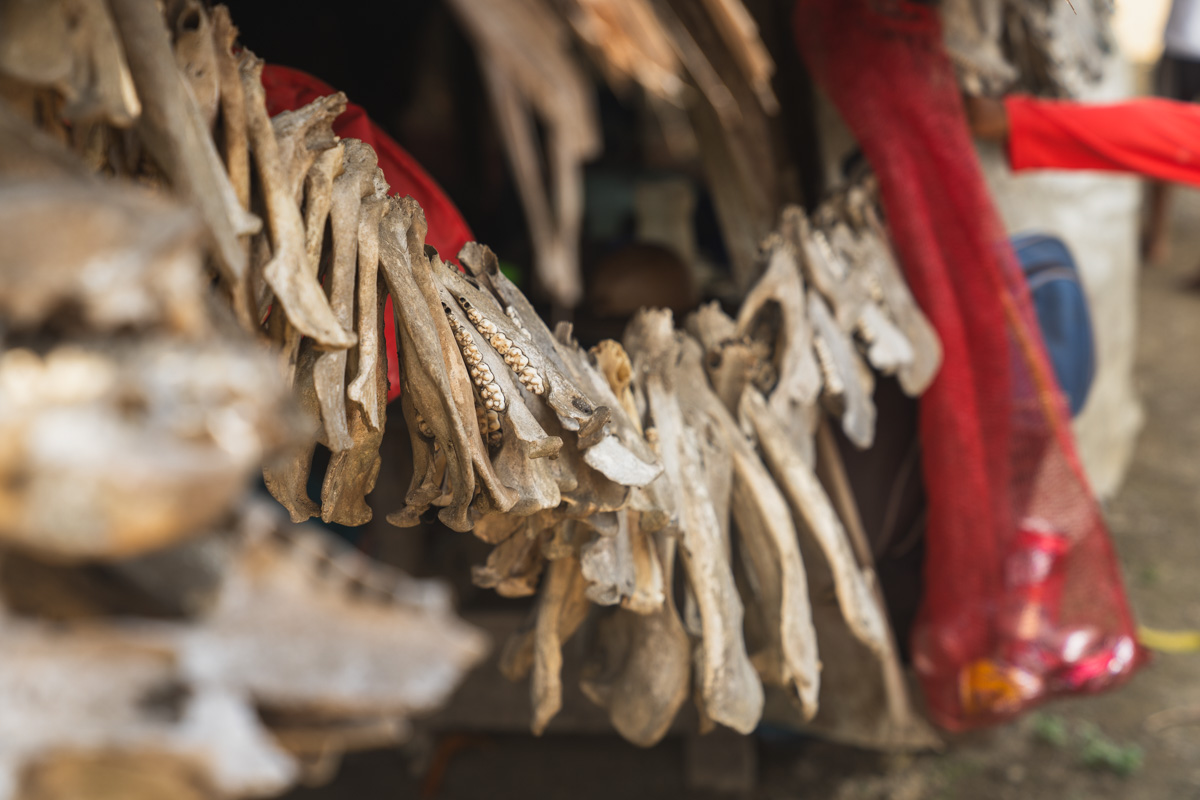

The. kids walked us around the whole island, showing off some of the unique things. One of the houses had an adorable tiny monkey as a pet. It was partially sad to see because the little monkey was tied up and very clearly scared to death.
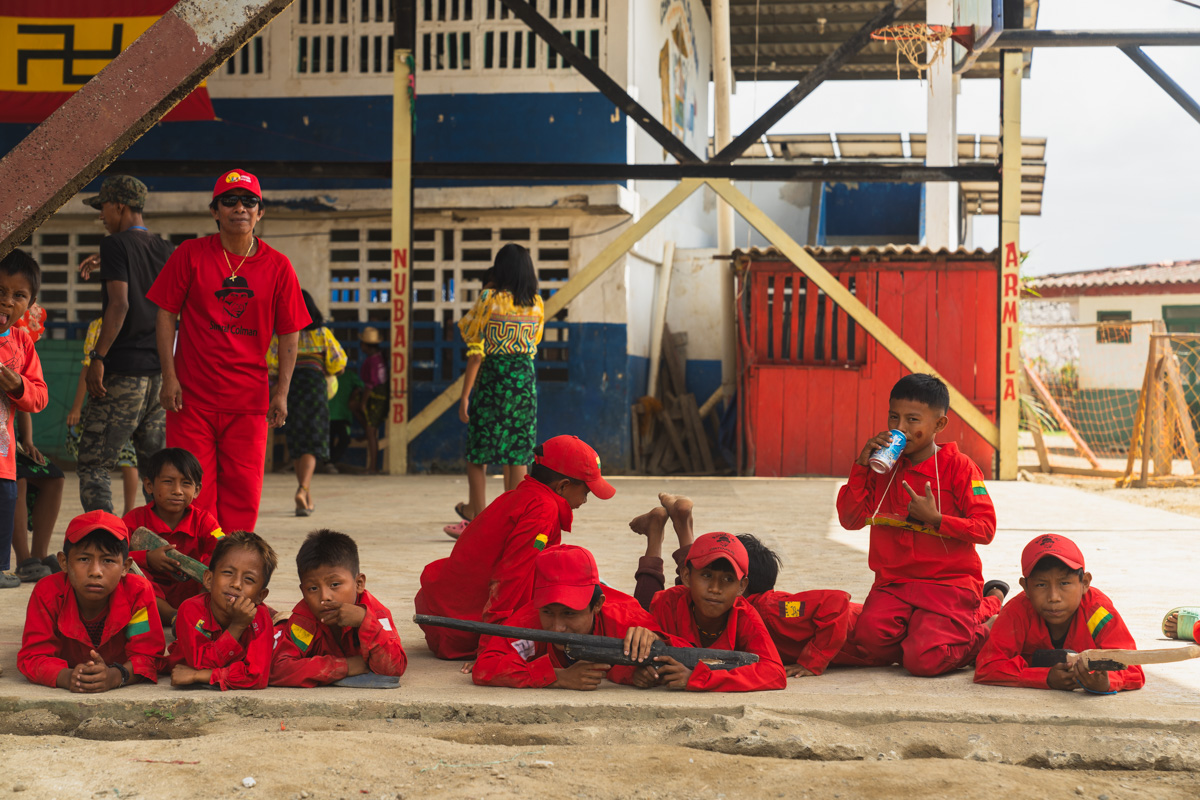
A big part of the celebrations would be reenactments. The people dressed up in red represent the Guna Yala and anyone dressed in camo represents the Panamanian Army. Here they were all practicing for tomorrow, when the real show would take place.
The competitions were about to start, the first one being a cayuco race. We followed the crowd to the dock where it was starting and people started looking at us and egging us on to join in our inflatable kayaks. We felt extremely confident that with all our paddling and our modern kayaks and oars, we stood a pretty good chance of winning. We cockily hopped in the water with one of our kayaks and readied at the start line along with three other teams, waiting for the sound to start.
As soon as it began, we paddled harder and faster than ever before. Very quickly, our confidence was humbled, and every other competitor passed us. Who would have thought that people who paddle practically every day for livelihood could be so strong and fast? While we pulled up in last place, our disappointment in losing was quickly washed away as everyone was cheering us on and seemed so excited to have us join in. A guy who was live-streaming the event interviewed us as well.


After the men’s race, there was a women’s race. Two of the women wanted to use our kayak to compete and we gladly let them. These ladies were strong and managed to pull off second place. It was pretty amazing watching them compete in our kayak.
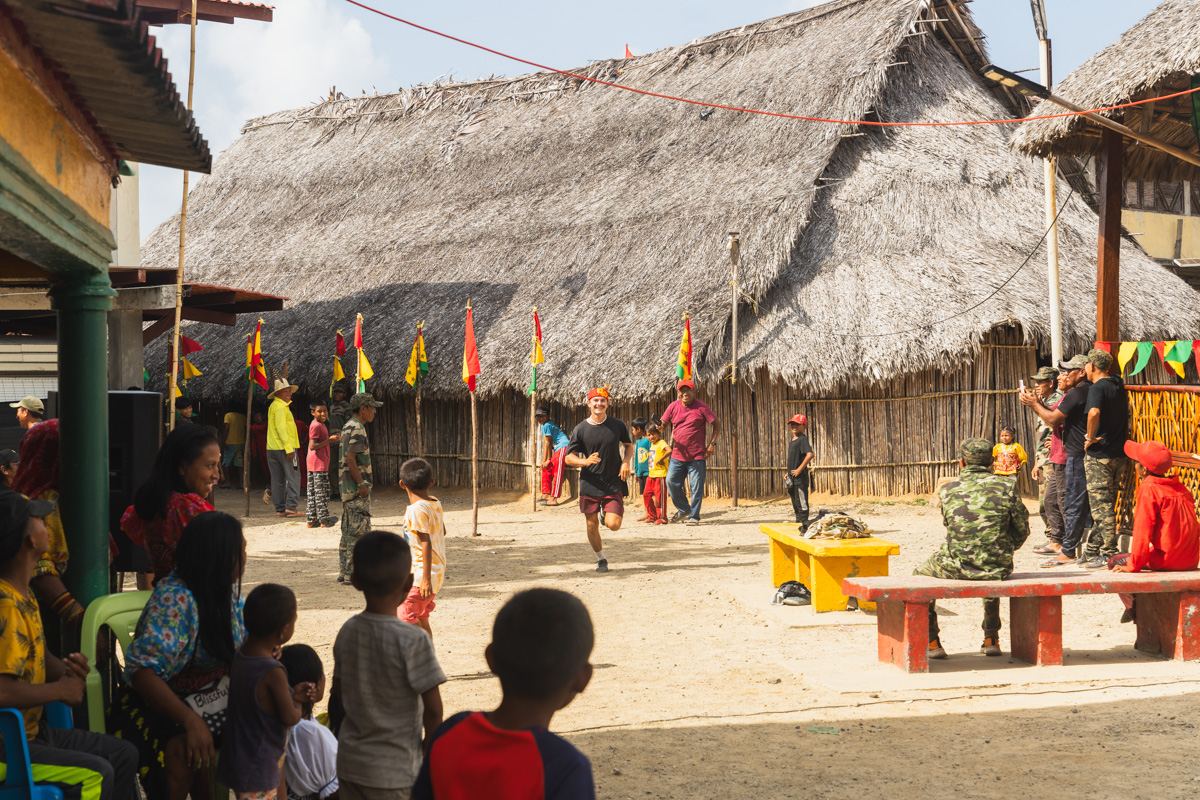
Sometime later, we heard that a footrace was taking place around the island. Kacper was keen on competing and lined up with about 10 other young men. At first, he thought it was going to be a quick, few-lap race, but then he found out it was 10 laps around this island and it would be nearly 20 minutes of running. He wasn’t the fastest runner from the start and was left near the back of the pack. But, with each passing lap, more and more of the competitors slowed down and some even quit.
I had struggled to keep track of who was winning as there were many racers and some were on different laps, but out of nowhere Kacper came around and was the first person to complete 10 laps! It was amazing and exciting to watch as people crowded around him congratulating him.
Kacper had won a competition and I was pretty keen to get a win myself. To my disbelief, the next competition was a beer-drinking race. I, a Southern frat boy who has been chugging beers since I was 18, was more than ready to compete in this. I had always considered myself a fast beer chugger and I knew this was my time to shine. I was so excited that I was also pretty nervous, I desperately wanted to win this. It would make such a cool story to tell when I’m older, about that time I won a beer-drinking race on an indigenous island in Panama.
I lined up with about five Guna men around a table with a beer for each of us. On the mark, we would grab them, open them, and the first person to drink it all and slam it down would win. I was honestly shaking a bit I was so nervous, I don’t know why it got to me so much, I just really wanted to win.
At the sound, I rushed and grabbed my beer and cracked it with a lot of force. The beers were warm and foamed a ton when they were opened. I went to chug with my usual strategy of squeezing the can and inhaling it all in a few sips, but I wasn’t ready for the foam. I inhaled some of the foam and tried to fight through it and drink all the beer also, but I couldn’t take it and ended up choking, literally. I coughed and coughed while all the other competitors finished and slammed their beers. A massive feeling of disappointment washed over me as I looked around, eyes watering from my coughing fit. I shamefully finished my beer and went to hide in the crowd.
I know it seems rather stupid, but I was pretty upset about losing so badly. I put way too much pressure on myself and I wanted to win so badly that I was nervous and messed up. I’m sure I could have won if I was calm, cool, and collected. Sadly I won’t get another chance.
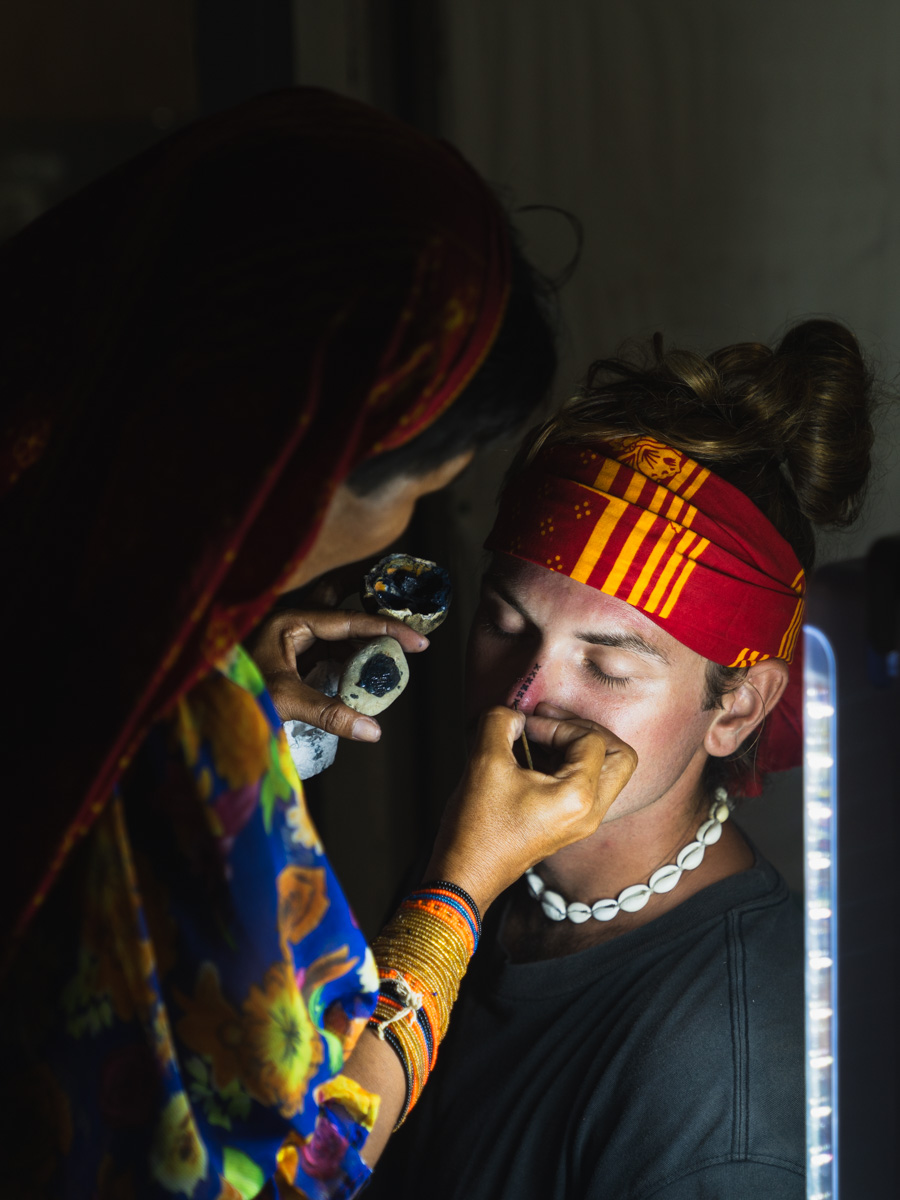
In the evening we were invited to have our noses painted like all the Guna people had done. It felt like a real honor to be included as much as we had been. These people didn’t want us here just to watch and observe, they wanted us to celebrate along with them.
DAY 31
Today was the day. The biggest day of celebration, and it would be going on all day, starting early in the morning. Kacper and I hurried to the center to begin watching. Everyone was dressed so colorfully and beautifully. The first event of the day was a speech where they talked about what they went through and fought for nearly 100 years ago. I felt so lucky to be here and experience this. I took countless photos as I couldn’t believe how beautiful everyone looked and was dressed. Enjoy some of my favorites.





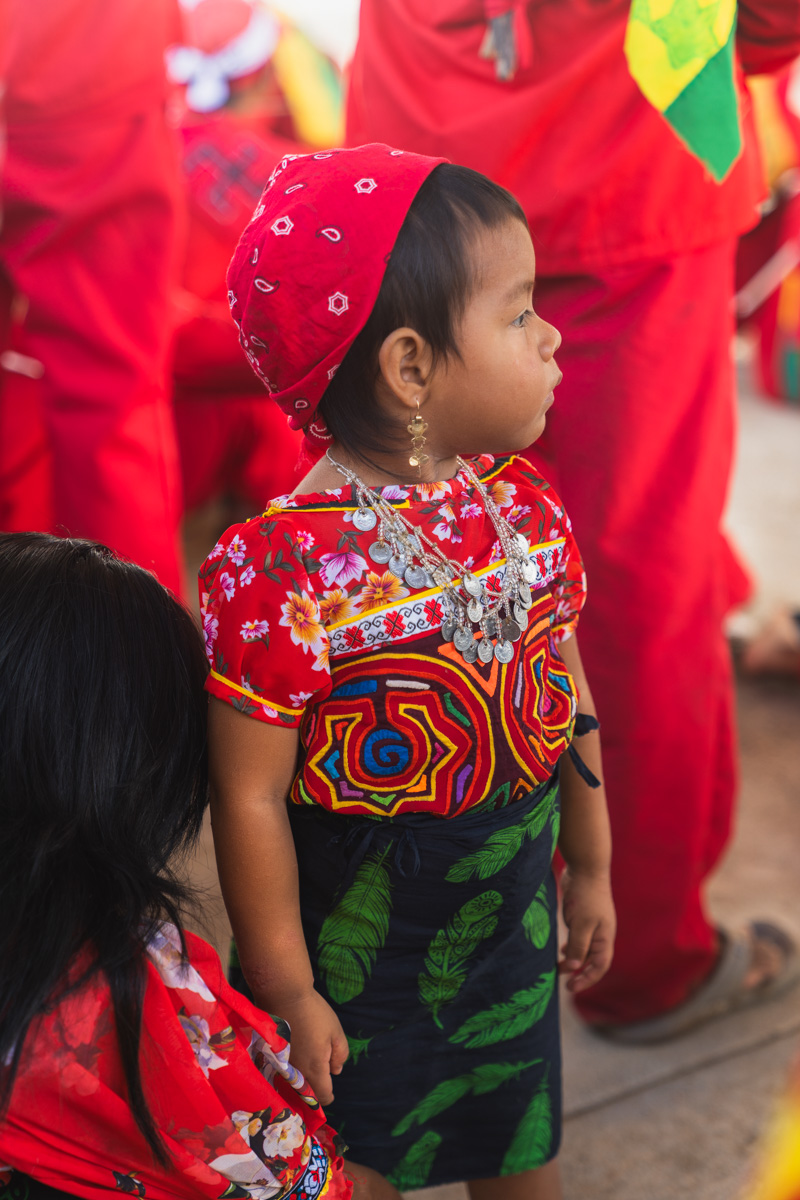
I really loved the clothes the women wore here. They are called Molas, and while the women don’t usually wear them year-round, they wear them proudly during this month. During the forced assimilation before the revolution, this type of clothing was banned by the Panamanian Government.

After the introduction speech, there was a massive parade around the town. There must have been a couple thousand people here on this tiny island for today.
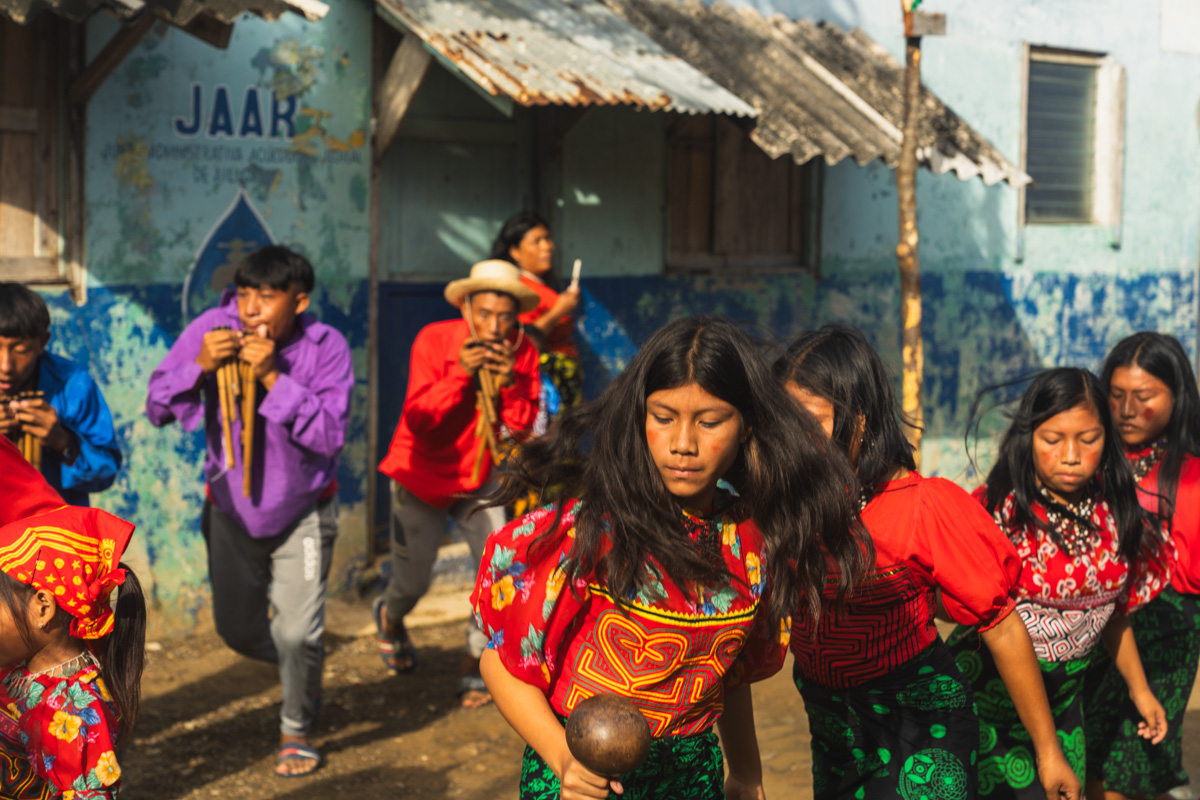
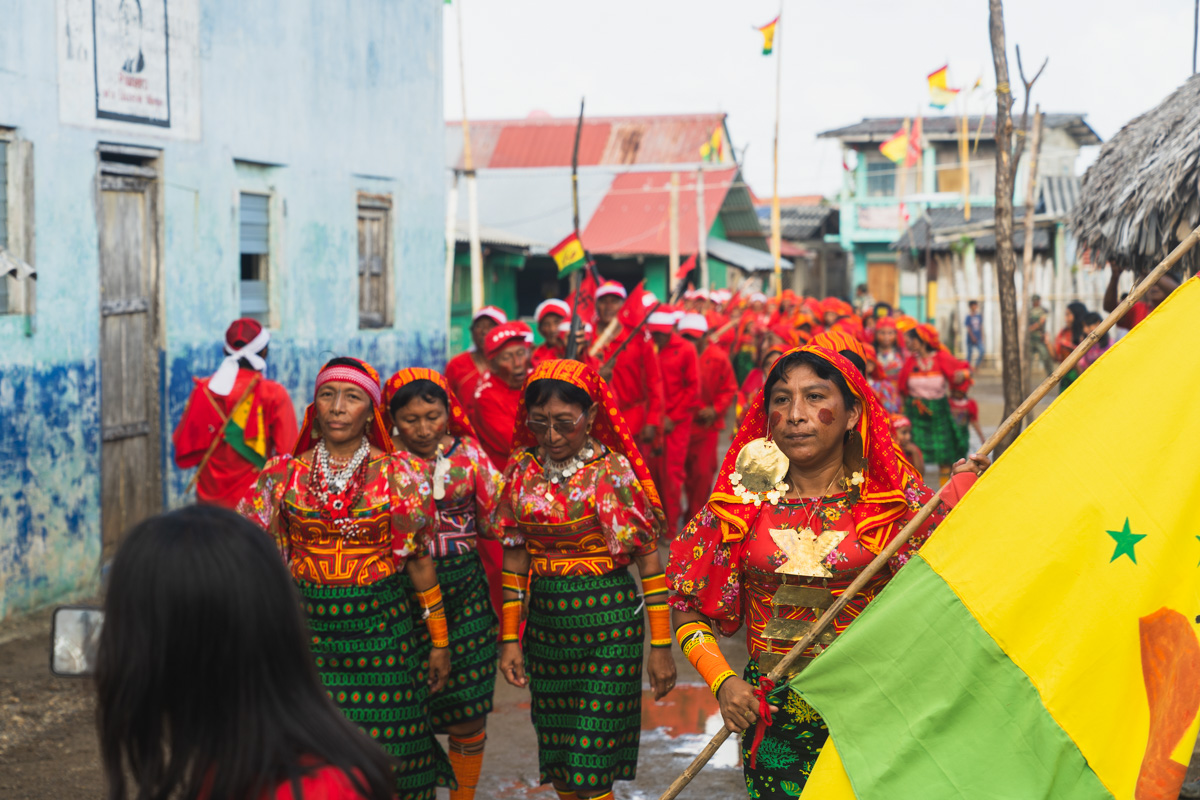
The parade ended with everyone gathering around the basketball court in the middle, where the rest of the celebration would take place.
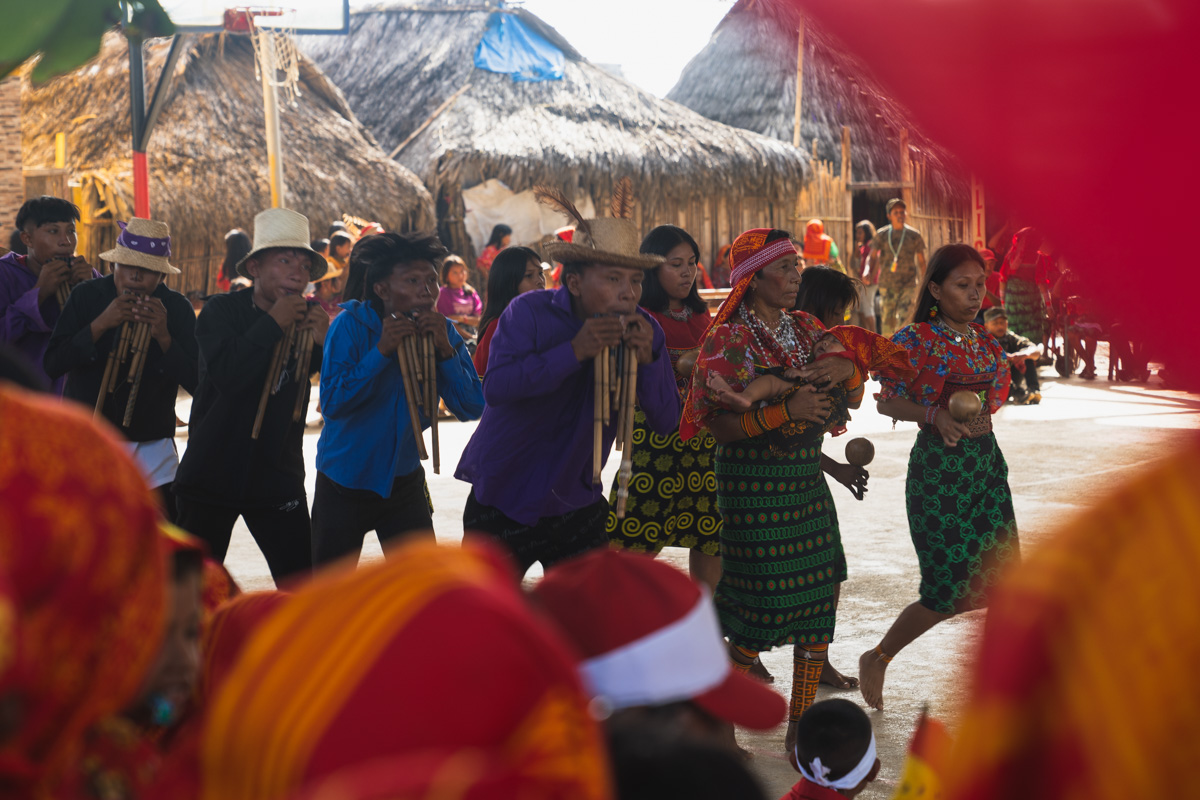



There were a lot of reenactments and stories told about what took place during the revolution. It started with the Panamanian government bullying and killing Guna people.
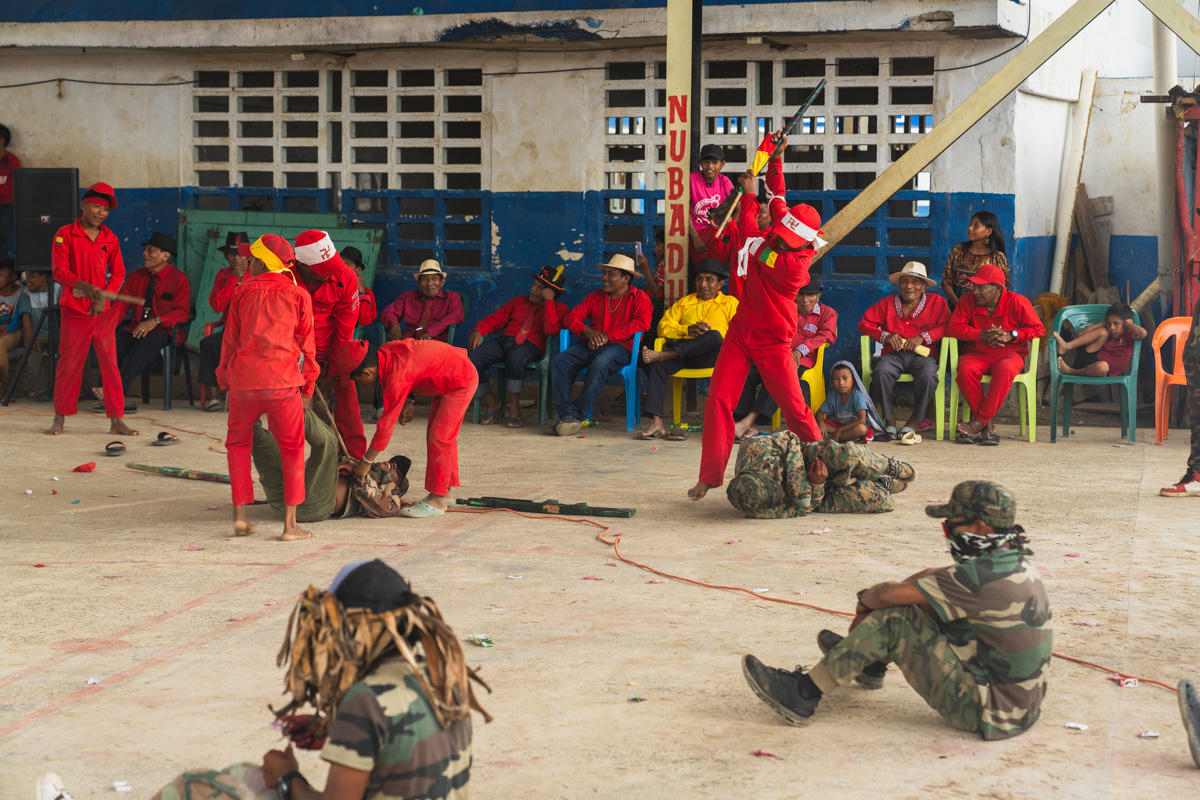
But it ended with the Guna finally fighting back and winning. People all day had been telling us about chicha fuerte and how the day would end with that. We didn’t know much about it other than it was a homemade alcoholic drink and everyone was very excited about it.
After the reenacted victory of Guna Yala, things started to get crazy. The energy we felt was incredible and people were in amazing moods. Now everyone would be heading to the congress building as a parade of yelling and chanting. Some people pushed us to the front and the next thing Kacper and I know, we are leading the parade.


Before heading to the congress building, we stopped at a beach where a bottle of rum was passed around. They fed us many shots and as we yelled “Viva la revolucion”, everyone cheered us on. After finishing the bottle, the parade continued, with us in front, to the congress building.
As we arrived in the congress building, there was more yelling and excitement. Everyone was excited for the chicha fuerte.

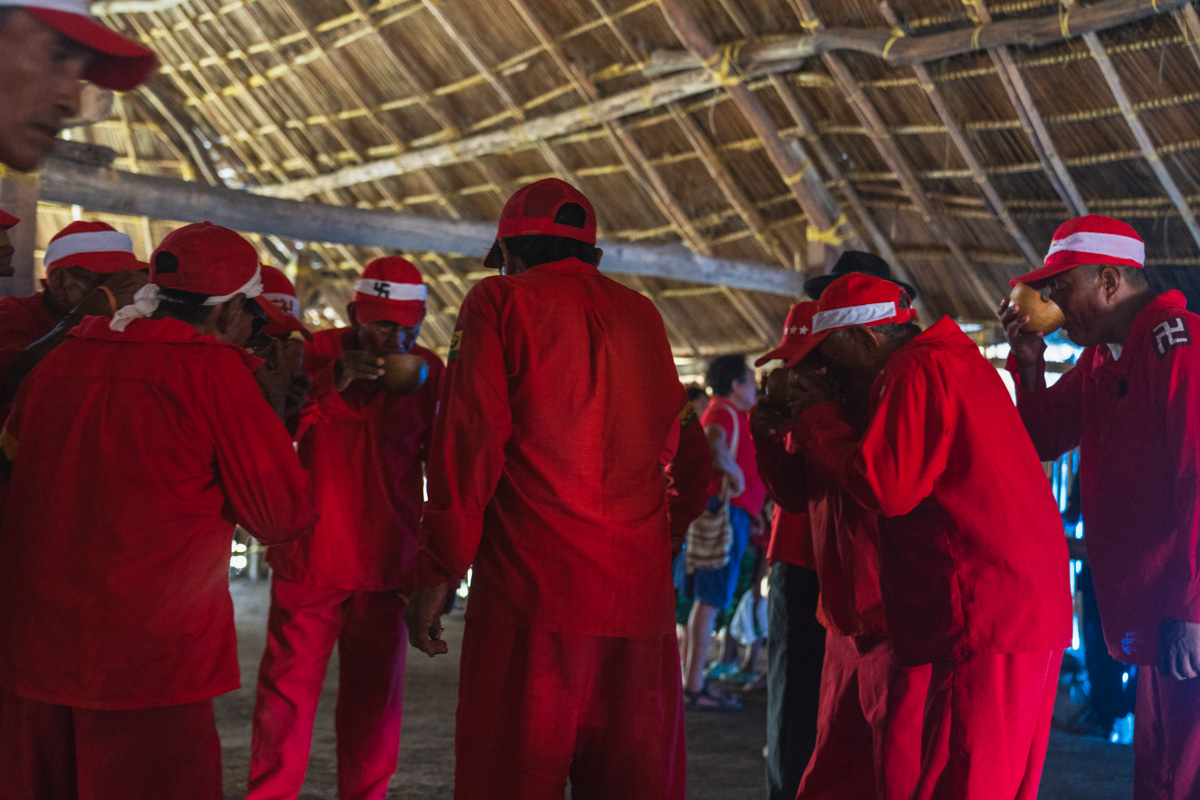
Some people helped guide us on how to perform the traditional passing of the chicha. There would be two lines of eight people, one group with coconut halves with chicha in it. The two groups would walk towards each other, and then walk away two times while chanting. On the third time, the group with the chicha would pass it to the other group, who would then circle up and cheer loudly and then drink the chicha. After you drank, you then were the group who refilled the coconuts and would pass it to the next group.
I really enjoyed the chicha after trying it for the first time. It’s some combination of cocoa, sugarcane, and corn fermented together. It has a chocolately appearance and flavor. I would estimate it to be around 15%-20% alcohol, so it was pretty smooth.
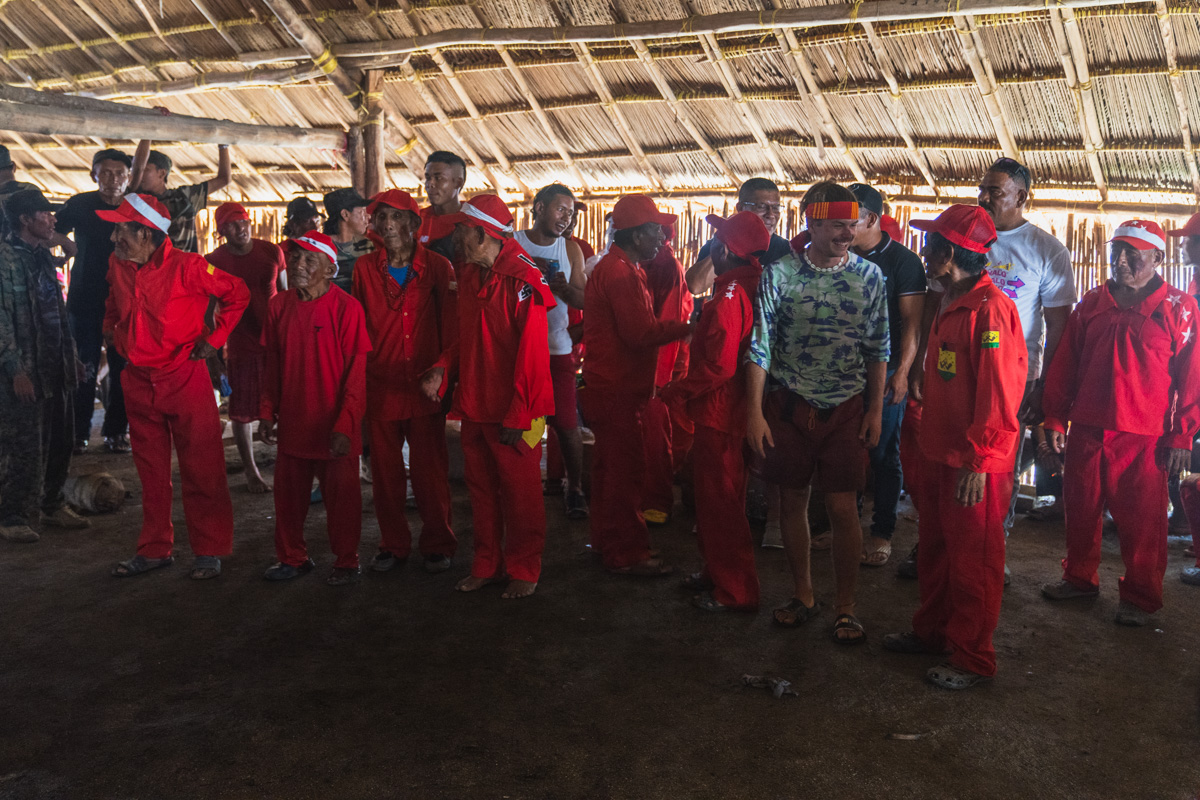
I originally thought this was going to be a two or three drink per person thing and then be done. Boy, was I wrong. This went on for hours. What started as the elaborate traditional passing of chicha slowly turned into everyone filling up a coconut, drinking more, and passing it around. Before I knew it, I was drunk. Everyone was drunk. It was the drunkest I had been in a long time.
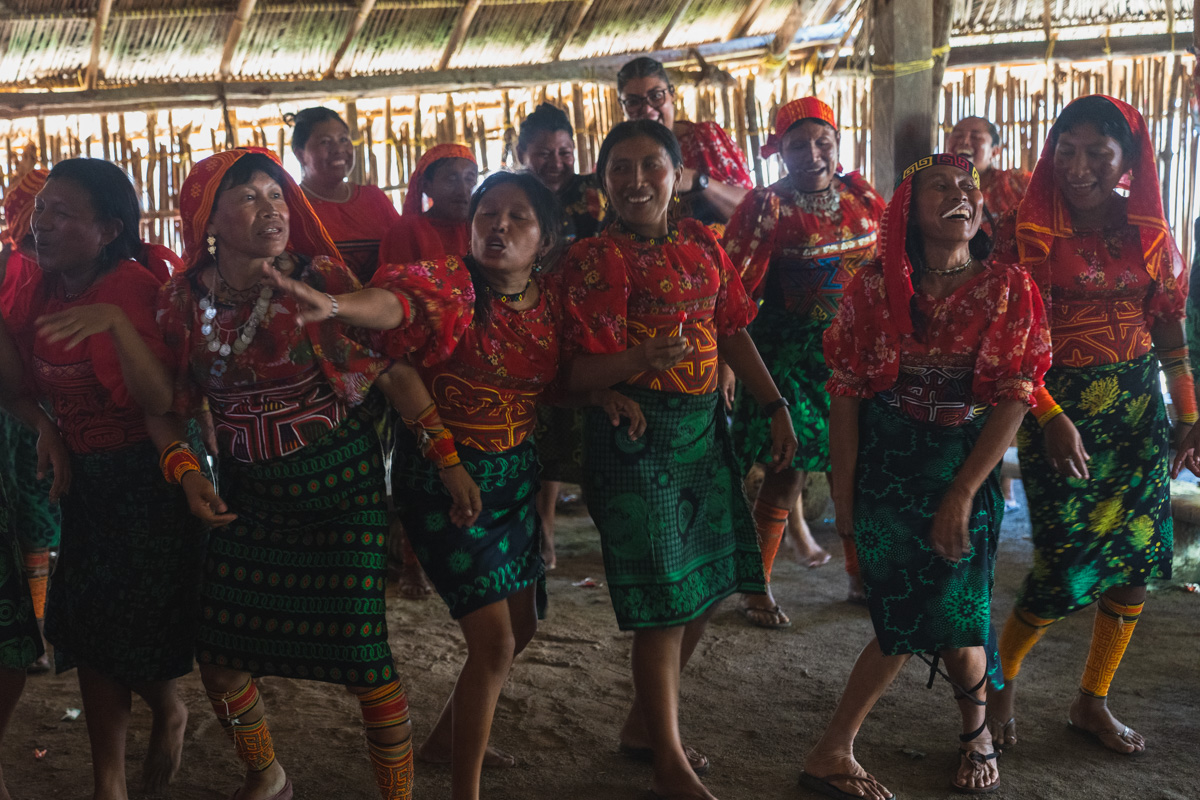
There was a men’s side and a women’s side. The women were hilariously drunk and it was so funny to watch. One of them saw Kacper and I watching and yelled at us “I AM DRUUUUUUUNNNNK” while laughing. It was surreal.
The chicha ran out around 3pm and everyone was trashed, it felt like a college party. Somehow, Kacper and I got invited by a man named Sueno back to his house to drink more rum. This is where both Kacper and I’s memory starts to fade and the last thing we remember is stumbling back to our hammocks around 6pm and sleeping. I was so drunk I fell asleep on the concrete floor, a few steps from my hammock.
DAY 32
The island was very quiet the next day with everyone recovering from the craziness the night before. I still could hardly process what had happened myself. I’ve found sometimes it’s best to just not think too much and go along with whatever is happening.
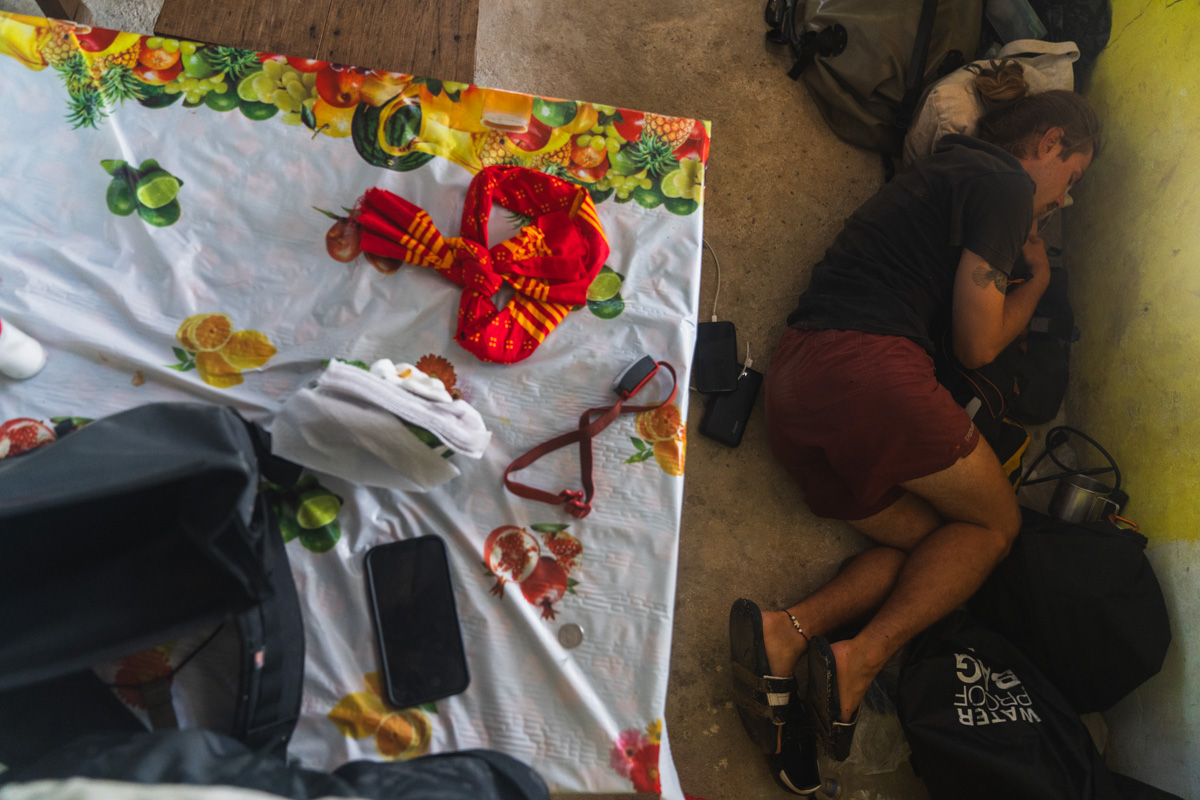
Kacper and I rested in the morning before it was time to continue paddling. We said our goodbyes to Dan and our many other friends on the island.
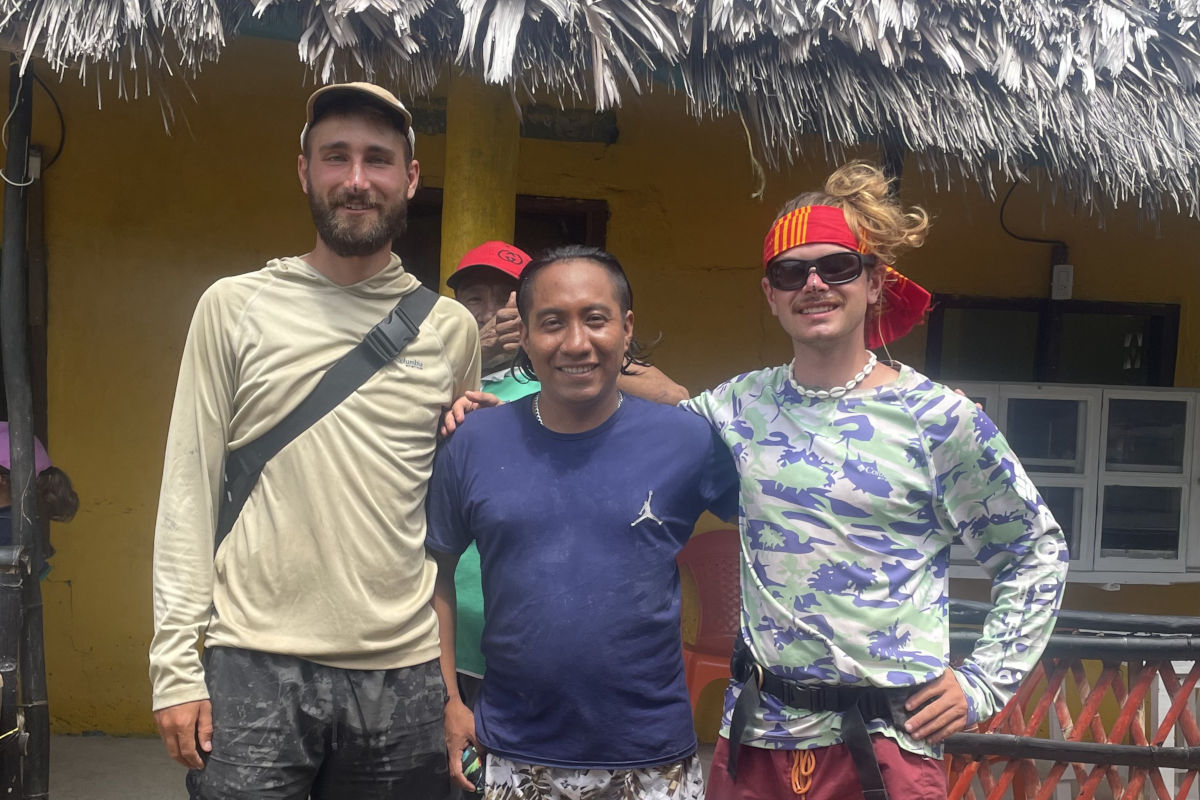

Thankfully today we were graced with a wonderful tailwind, an extremely rare thing on this trip. We were pretty exhausted all day so it was a very welcome assistance to the island of Ustupu.
Ustupu is the most populous island of all of Guna Yala. If my memory serves me right, I believe it has around 5,000 people living there. It was a pretty quiet and boring evening for us as we were still recovering from the celebration.
DAY 33
We woke up feeling pretty good and we realized we were so close to Colombia. After paddling through San Blas Islands, and then the crazy revolution celebration on Ailidgandi, it felt like the best of the trip was behind us. All that was left was to paddle the last section and finally arrive in Colombia. I felt stronger and more confident than ever. I had doubts for a while about whether or not I’d be able to make it to Colombia, but now I knew for sure I was making it. I was determined, but I was also ready to be done kayaking.
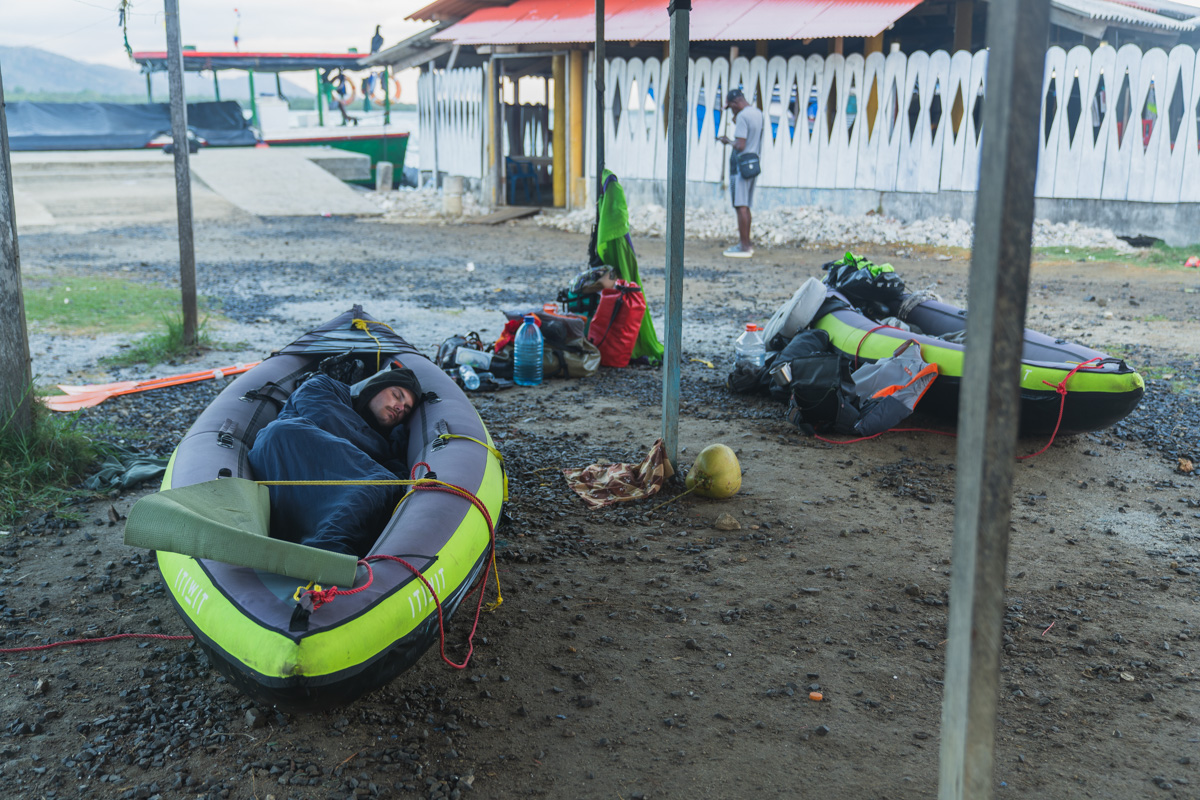
We had been sleeping in our hammocks the whole time but finally tried sleeping in the kayak for once. It was surprisingly comfortable and was essential to a big inflatable mattress.
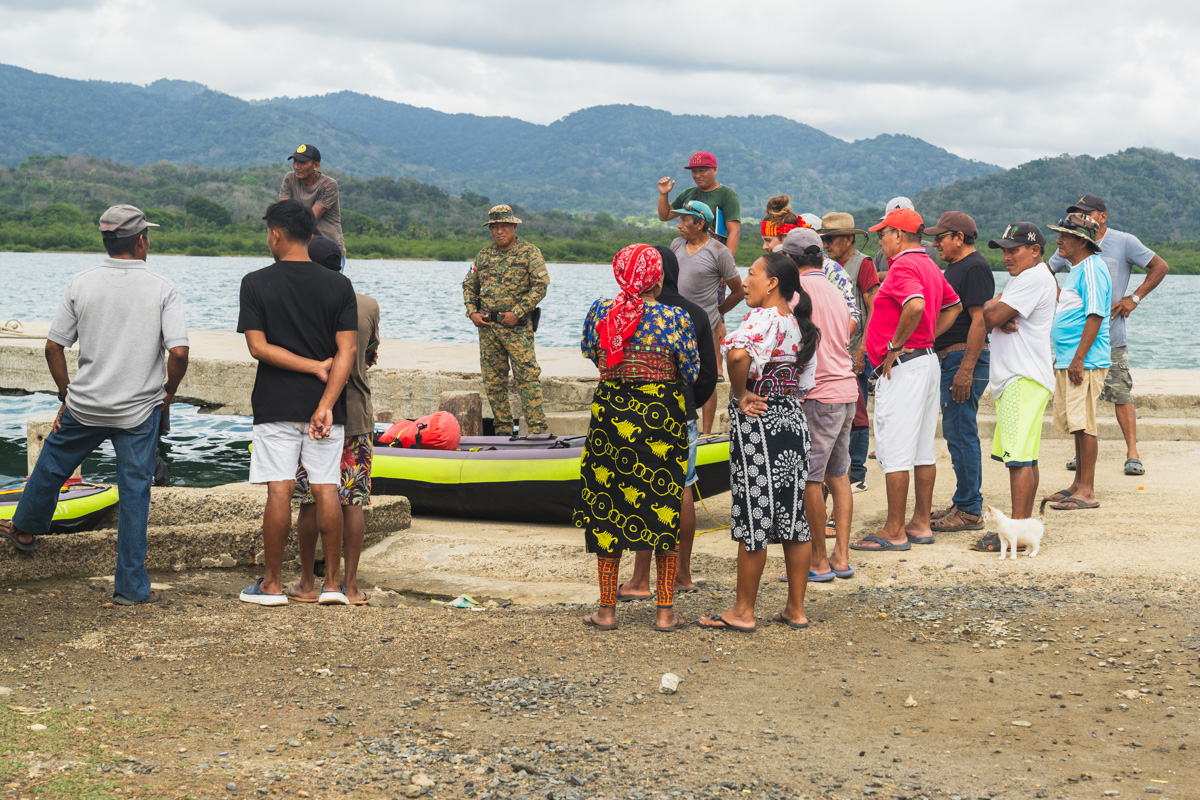

We would always attract quite a crowd when we arrived at a new community dock. People would always help us tie down our kayaks and then they would begin asking questions about us and what we were doing.
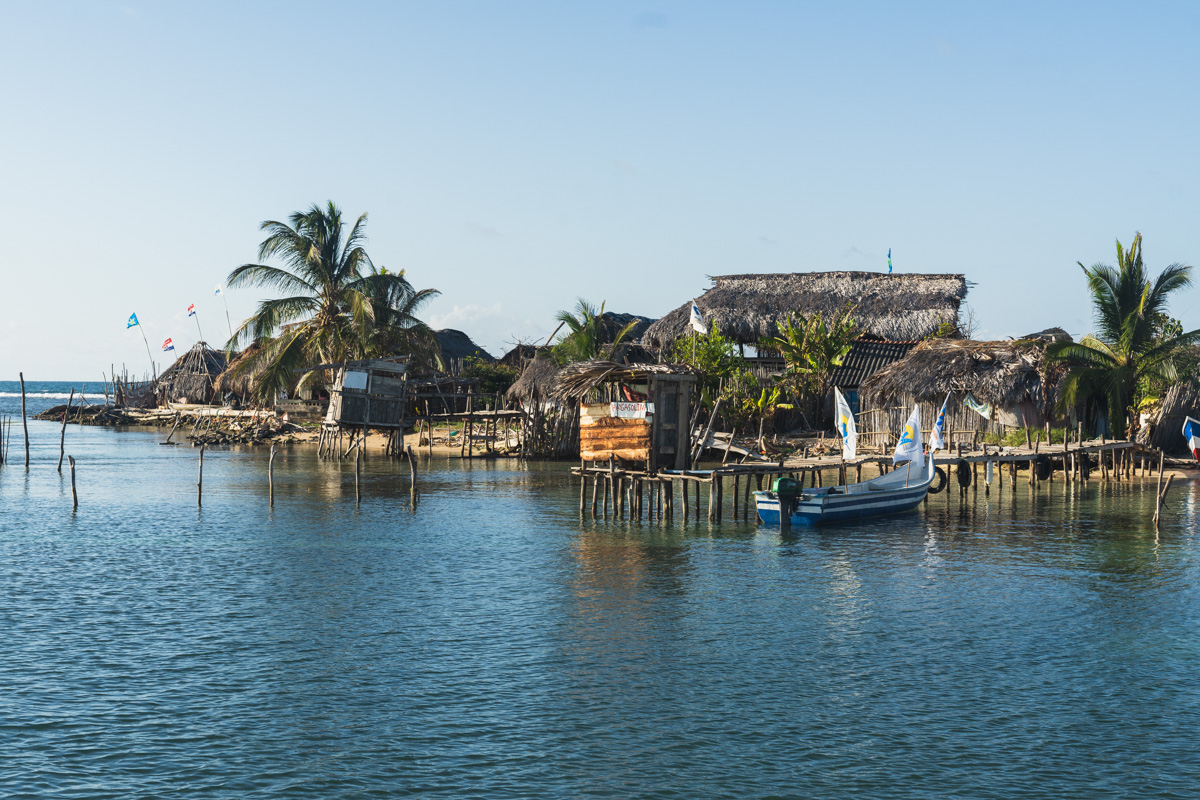
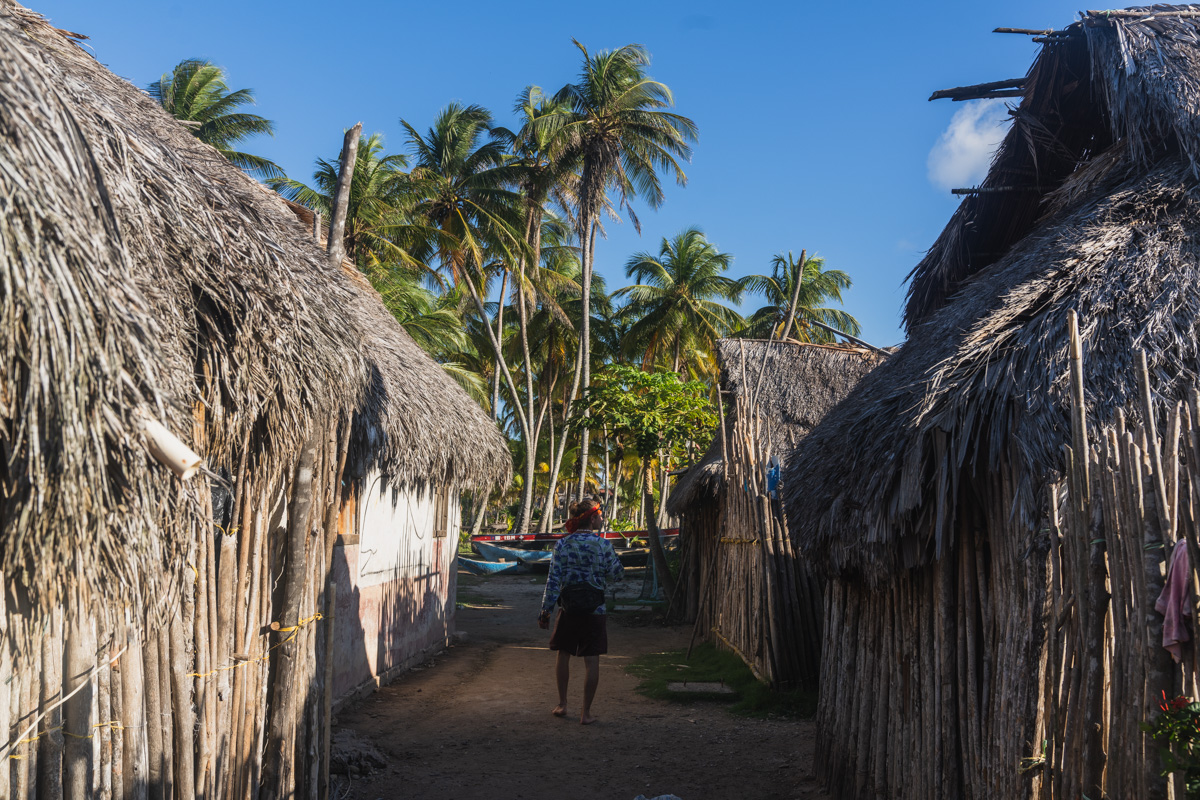
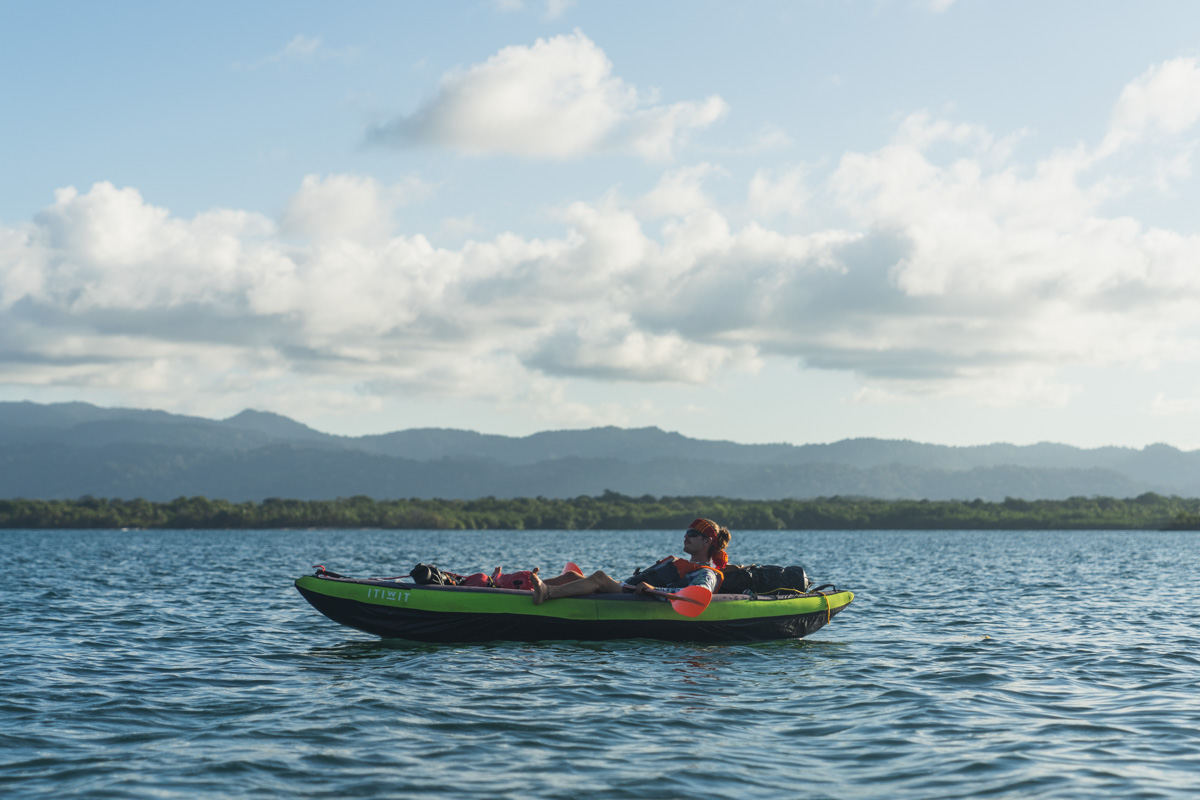
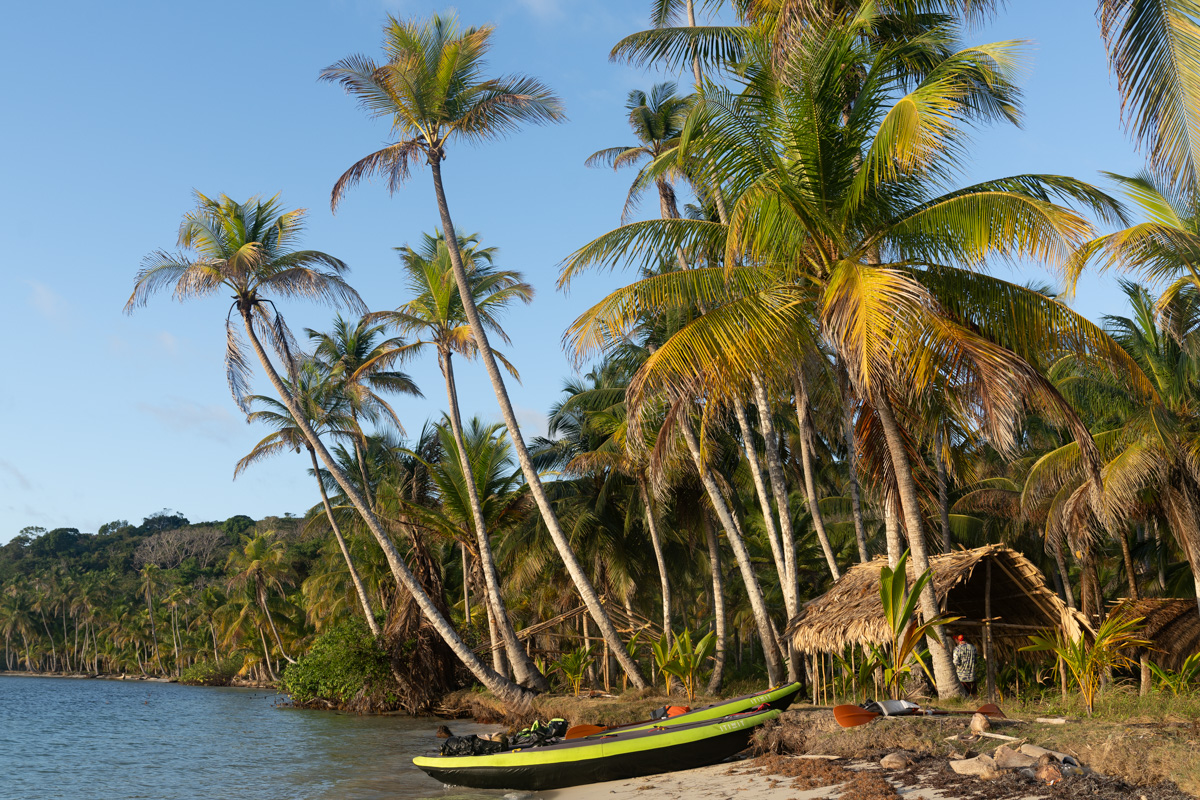
We finished the day on Isla Pino. It was an island, but a very large island. As the sun was setting we attempted to set up our hammocks underneath some palapas, but then the sand flies came out. Having experienced them before, we knew we needed to find somewhere else to sleep.


There was a small restaurant that was over the water where a few local guys were working. I went over and asked them if we could sleep here to hide from the bugs. They were really nice and thankfully allowed us to. Here, we would be far away from the sandflies and could sleep in peace.
DAY 34
Today was a rather exciting day because we would be entering the coastline of the Darien Jungle. It was a slow transition, but we noticed the coastline grew more inhospitable and rugged. Islands were fewer and farther from each other. The rougher coastline also lead to rougher paddling, as the waves would hit the rocky coasts and then be reflected back, creating waters with waves coming from every direction.

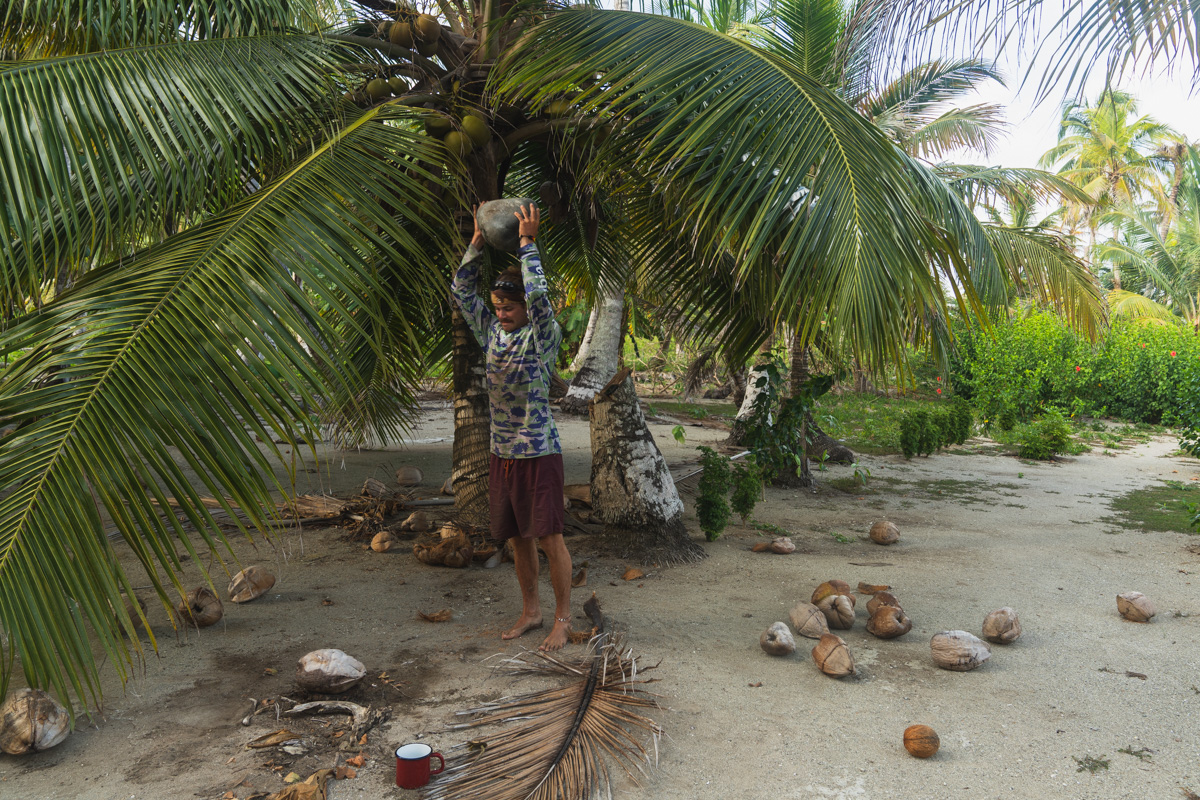
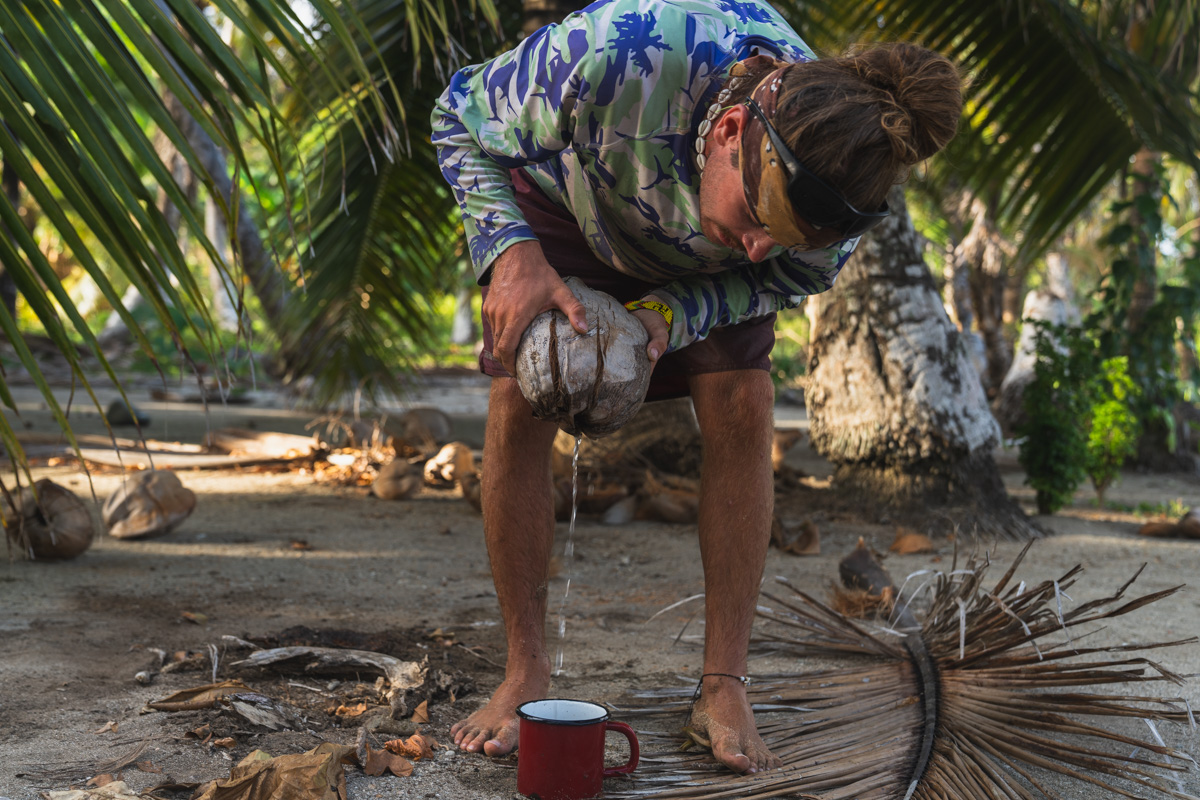
This would be our last island, but it turned out to be a wonderful one. It has a lot of ruins of buildings and was covered in fallen coconuts. We had gotten pretty efficient at opening coconuts and now used a massive rock to smash the coconut in seconds. We must have cracked 40 coconuts here and drank nearly a liter each of delicious coconut water. We even filled up a water bottle before paddling the last few kilometers to our destination.


We arrived in Carreto and as we beached our kayaks, we were immediately confused. Right in front of us was a massive structure with 20+ tents underneath it. As we got closer, we realized they were all Chinese people and there must have been 60ish of them. We tried to talk to some of them but they all only spoke Mandarin.
We then talked to some local guys and learned that these were migrants heading for the United States. I had always heard about the migrants who travel through the Darien from Colombia to Panama, but I didn’t know I would arrive on part of the route. I had heard it was mostly Venezuelans and Haitians coming through here but never would have expected a group of Chinese people.
The migrants camp here before making the hike through the jungle to the highway in Panama on their way to the US border. It’s a massive industry, making the cartels involved millions, billions of dollars. At this point, the route is very established. In this small indigenous town, there are all these amenities for the migrants. Structures have been built for them to camp, there are bathrooms and showers, and even wifi available. This town profits a lot from it as well, as they have shops for the migrants to buy food and drinks, plus the locals guide them through this section of the jungle.
While Kacper and I were relaxing by our hammocks, a young Chinese boy walked over to me. He looked very friendly and handed me his phone with a translator open, wanting to talk to me. His name was Zhang and he was 16 years old. He was here with his father and they were going to the US with the hopes of finding better work. His family had fallen upon hard times in China and it was becoming increasingly difficult to find work. They had to leave behind his mother, sister, and girlfriend in China for the time being. They were planning to make it to NYC where they had some other relatives with Chinese restaurants where they could work.

I was asking him lots of questions about his trip. They had started in Quito, Ecuador, and then been on busses to the Colombian coast where a boat took them to Capurgana. From there, they had to hike to this town, Carreto. From here, they had a two-day hike to the highway in Panama, where a system of busses existed to get them across every border to the US. It would take him about 20 more days to get to NYC. I asked him how much they paid, and he told me it was $27,000 per person. This was an incredible amount of money, as I had heard that most people paying for the trip from Colombia need around $4,000 – $7,000.
I was so interested in his trip and I kept telling him how crazy and challenging it must be for him to do this. It’s not an easy trip and it’s very hard to leave half of your family behind and go to a new country, a new culture, with a new language and start over. He would tell me that my trip was the crazy and challenging one. The big difference was I was doing my trip for fun and they were just trying to live and survive.
After a while, Zhang and I bonded over our mutual enjoyment of a few PC games. We swapped contact info and I told him to contact me when he got to NYC. He had to go back and sleep because they had an early morning to start the hike.
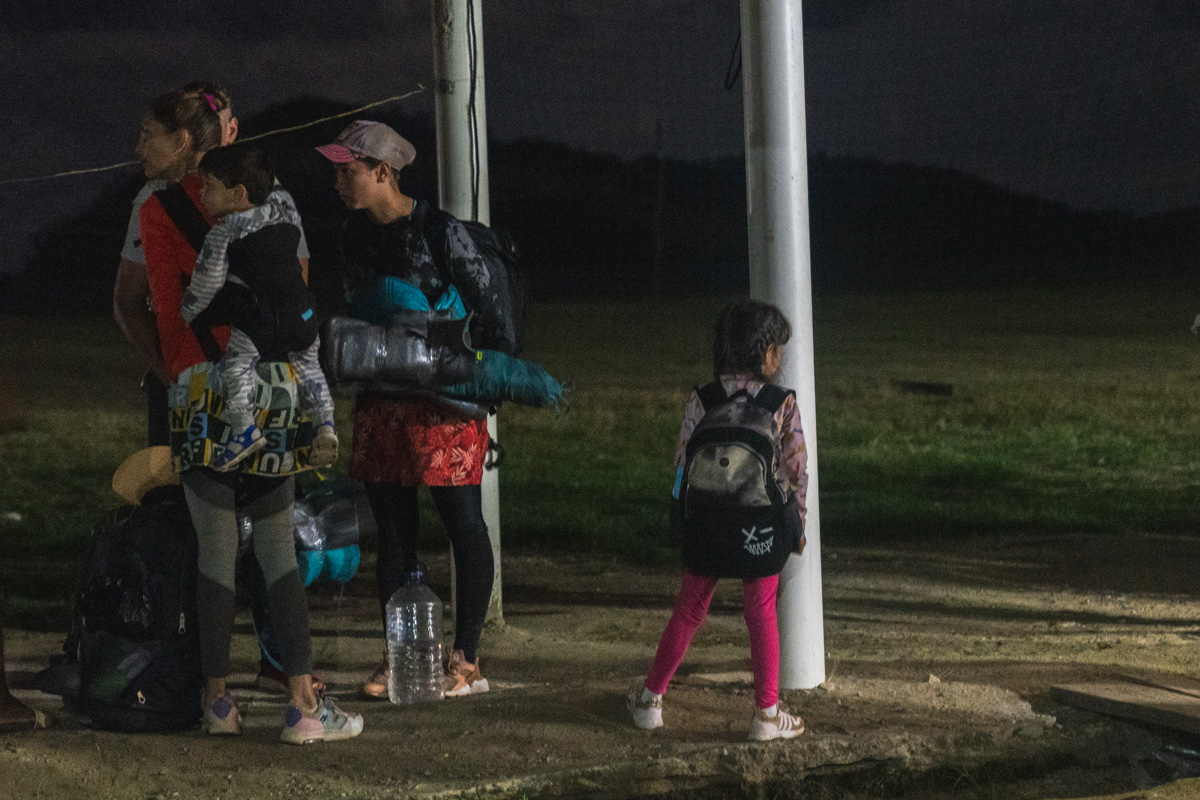
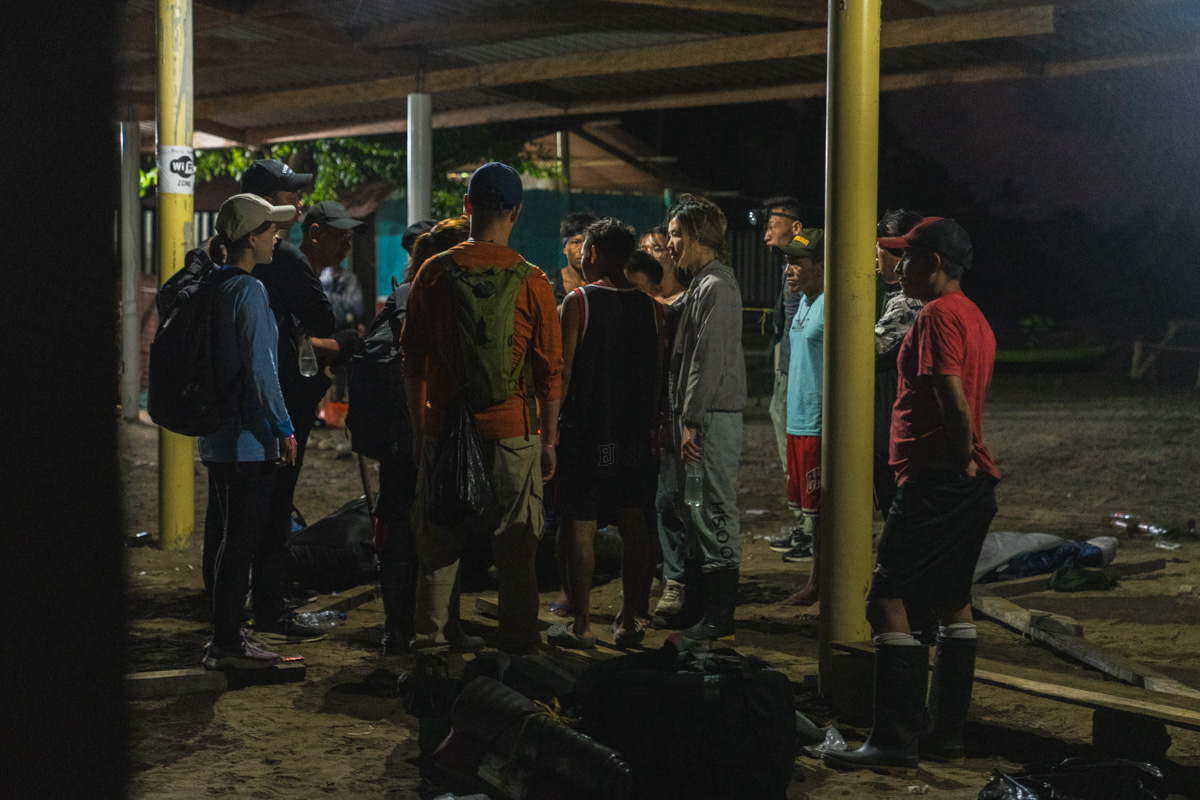
At 5am, the migrants packed up and got ready for their hike through the jungle. I said goodbye to Zhang and his father and wished them luck on their journey.
DAY 35
Today was a big day in a few ways. We were going to paddle to Puerto Obaldia, the last stop in Panama, where we would get our exit stamps. It was also a big day because it would be our first time unable to stop and rest along the way. It would be 25km nonstop as there wasn’t anywhere we could stop along the way.
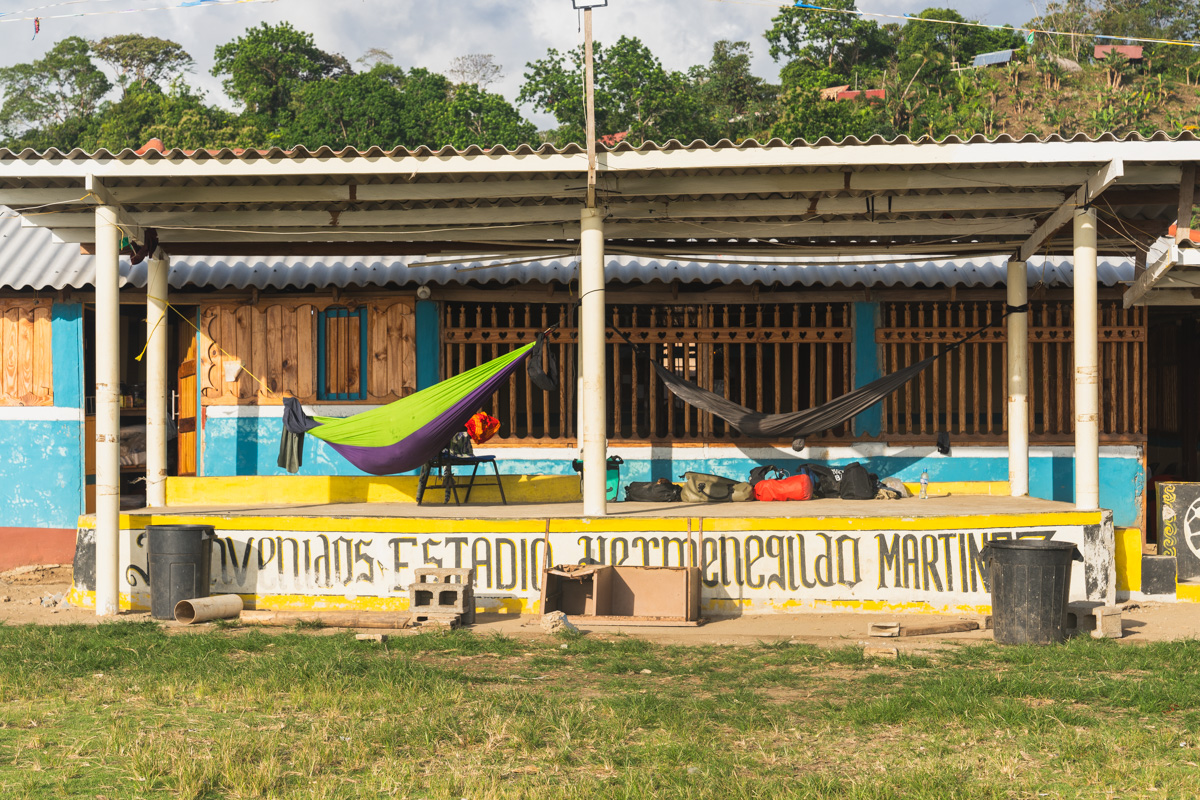
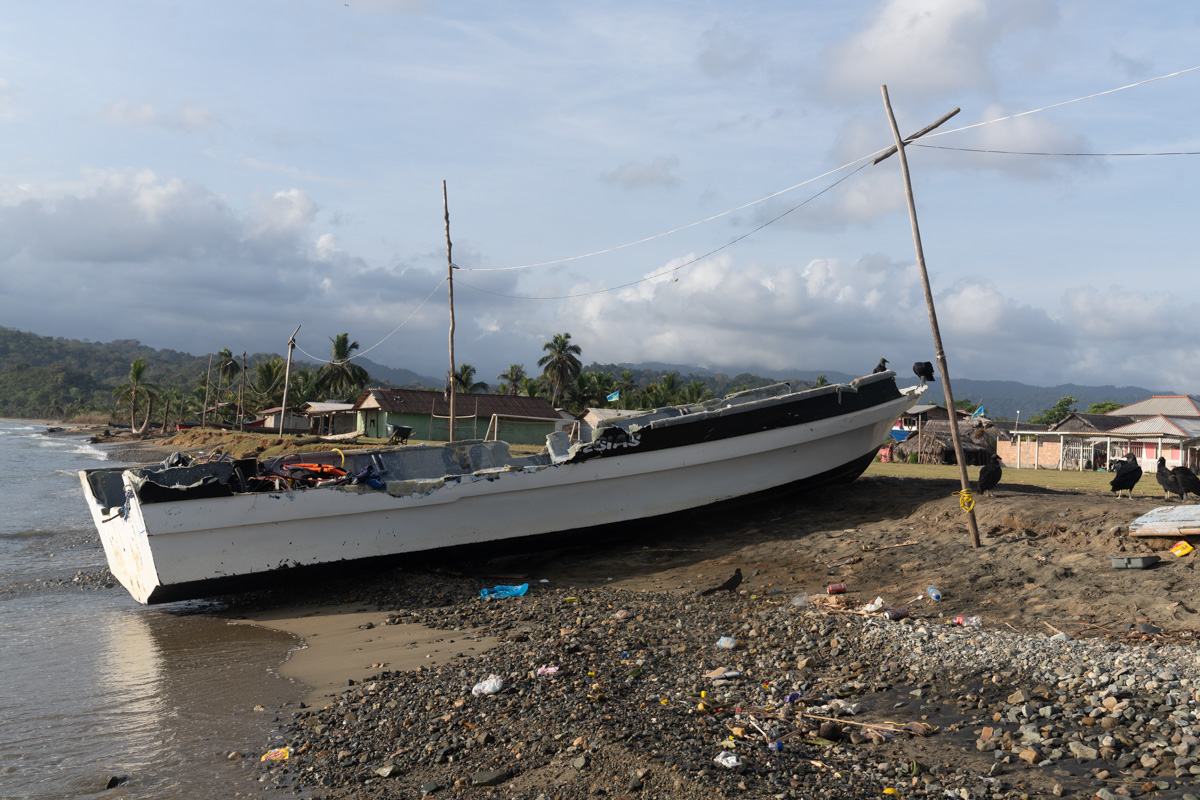
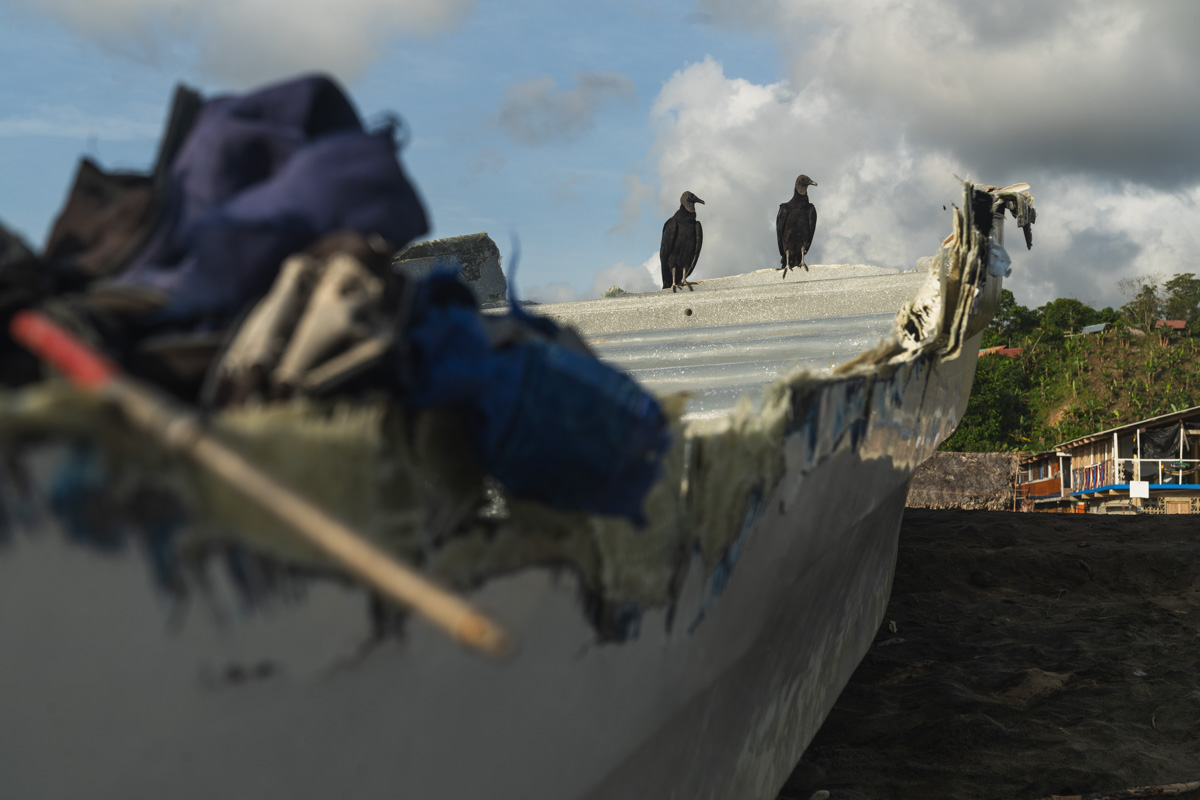
Before leaving town we saw a ruined boat on the beach. It turns out this was the boat we had heard about weeks ago that crashed and many people died on. It turns out it was a boat full of migrants traveling along the coast at night during rough weather. The boat capsized and people were tossed into the dark ocean. A truly nightmare situation to be in. The boat is situated right in front of the migrant camp, a strange reminder to all the migrants of the danger of their trip.
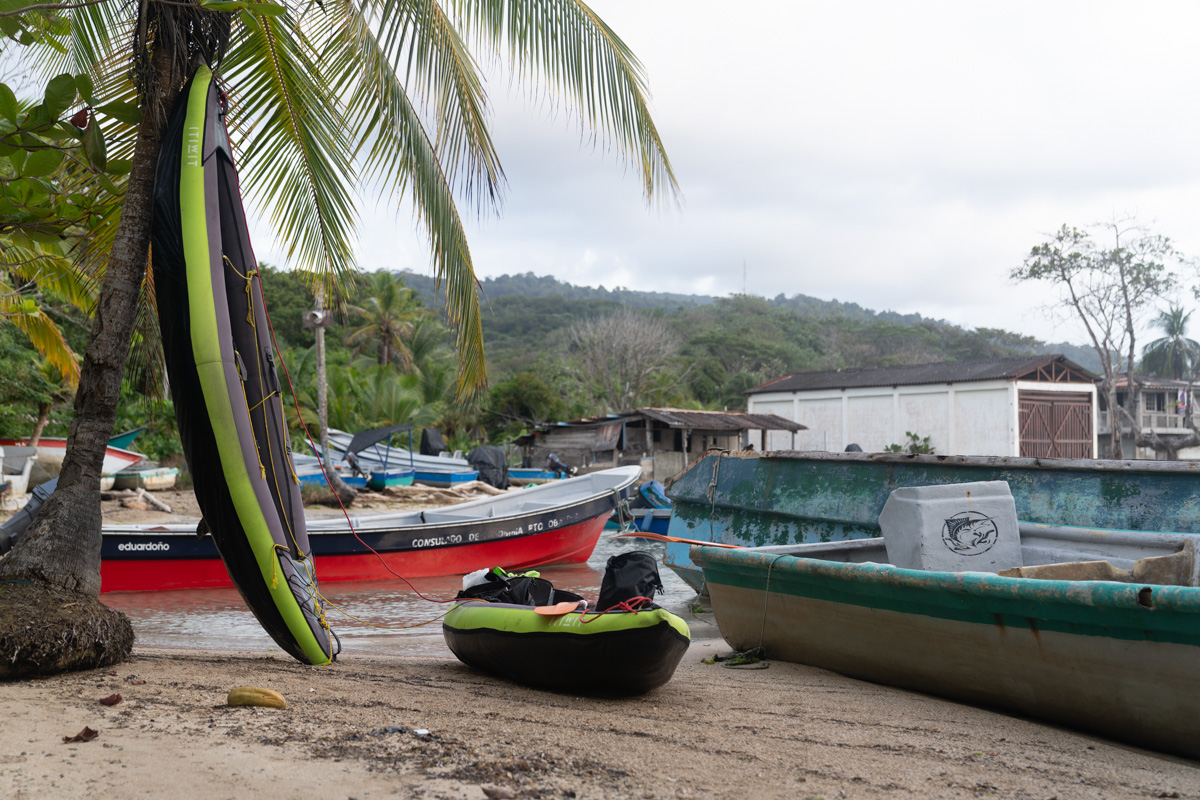
The nonstop paddle to Puerto Obaldia was tough. More mentally than anything. Usually, we have some checkpoints along the coast to look at and paddle towards as we slowly get closer. Today, we had nothing but the destination, seemingly forever away, to stare at as we paddled towards it. It was impossible not to look at and even as hours went by, it seemed to not get closer.
After nearly 7 hours, we finally arrived. As we arrived, we realized that we had left Guna Yala. Puerto Obaldia was a normal Carribean town and we wouldn’t see another Guna. We were still extremely excited, only one day separated us from Colombia now.
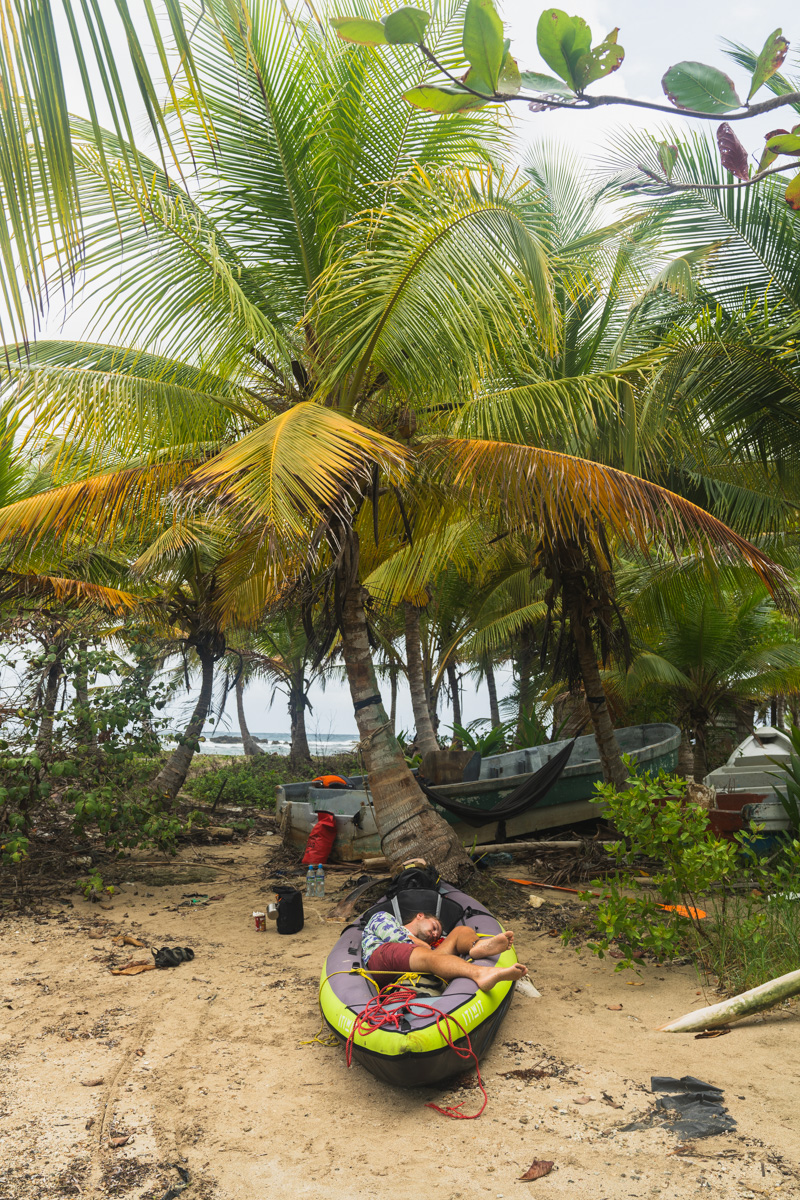
DAY 36
In the morning, we went to the migration building and got our exit stamps for Panama. We took our last few steps on North American soil, and set off towards South America.
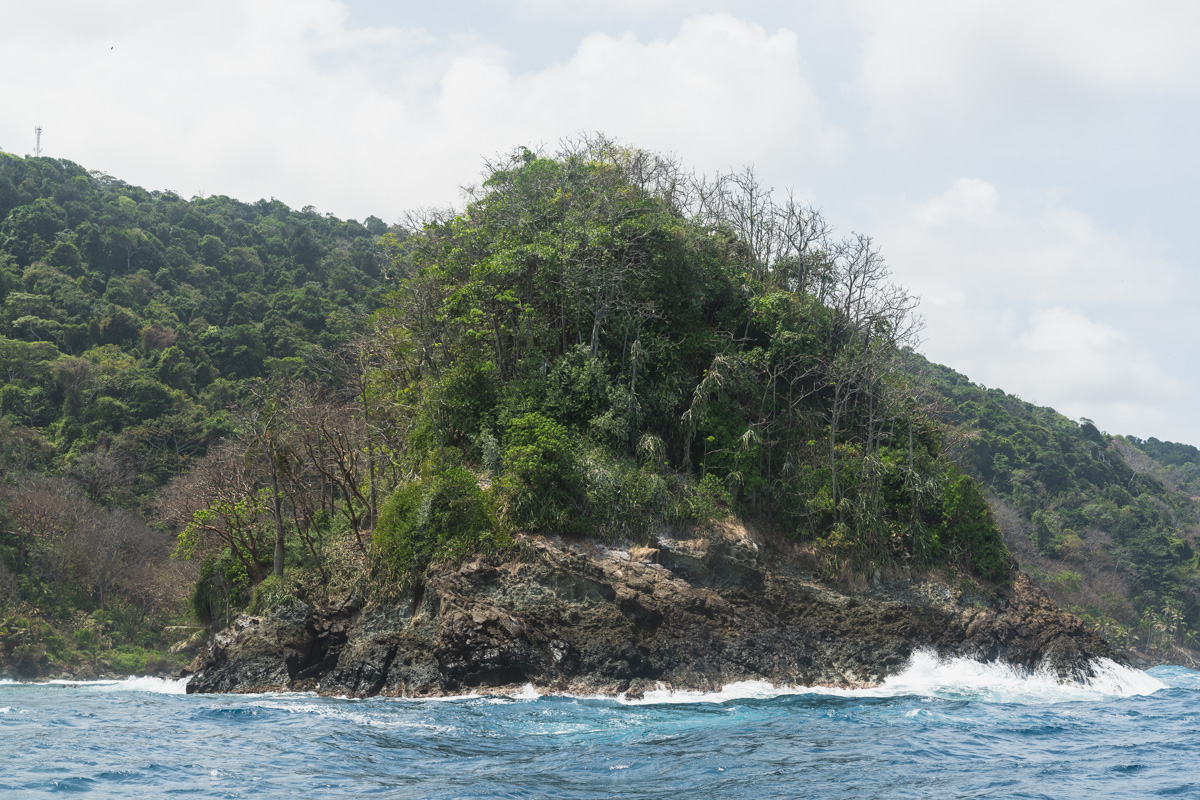
The journey was short but incredibly rough. The coastline was as rocky as ever and we had to face the wild and random waves they caused. At this point, we were unstoppable and paddled nonstop, fully of excitement. Getting around the tip to the border was the toughest part, as we had to face the current as well.
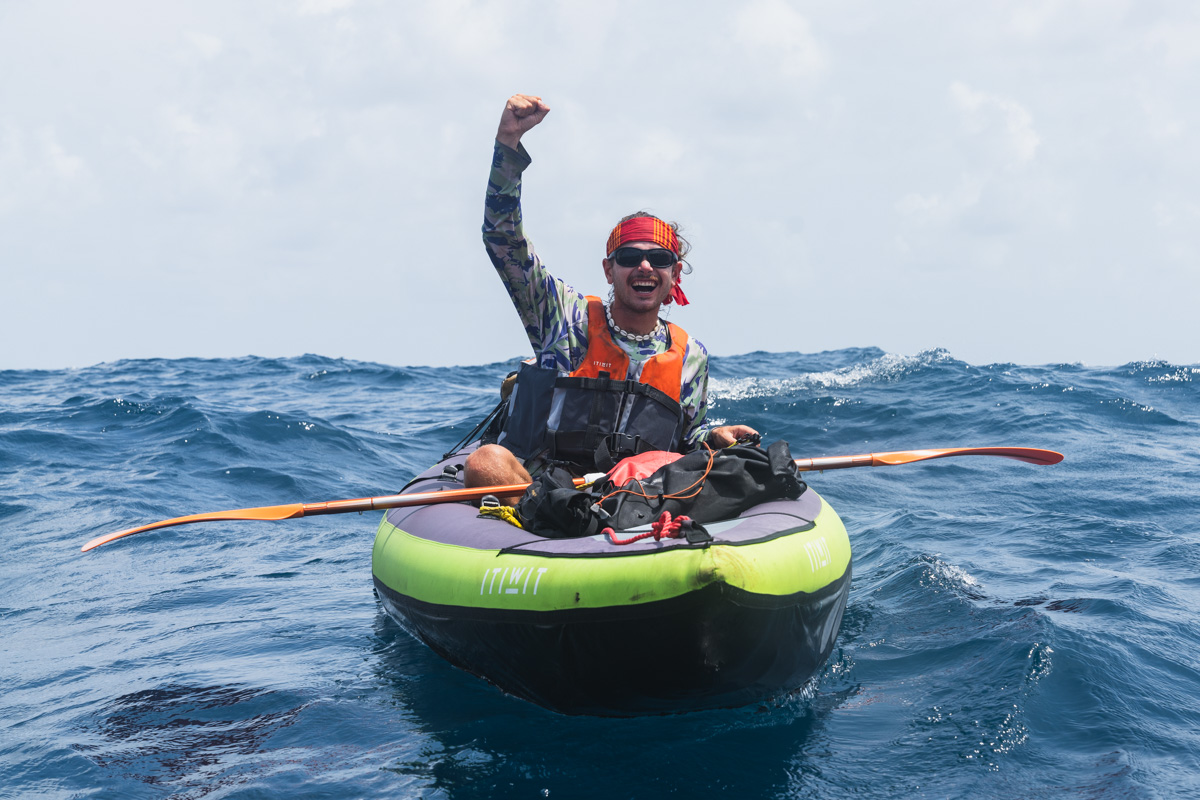
After checking our phones multiple times, trying to look for when we crossed the ocean border, we finally did it. We had a short celebration in the water before continuing. By now, we had made it around the rocky point and the waves were at our backs, helping us out immensely. We hardly had to paddle on our way into Capurgana.
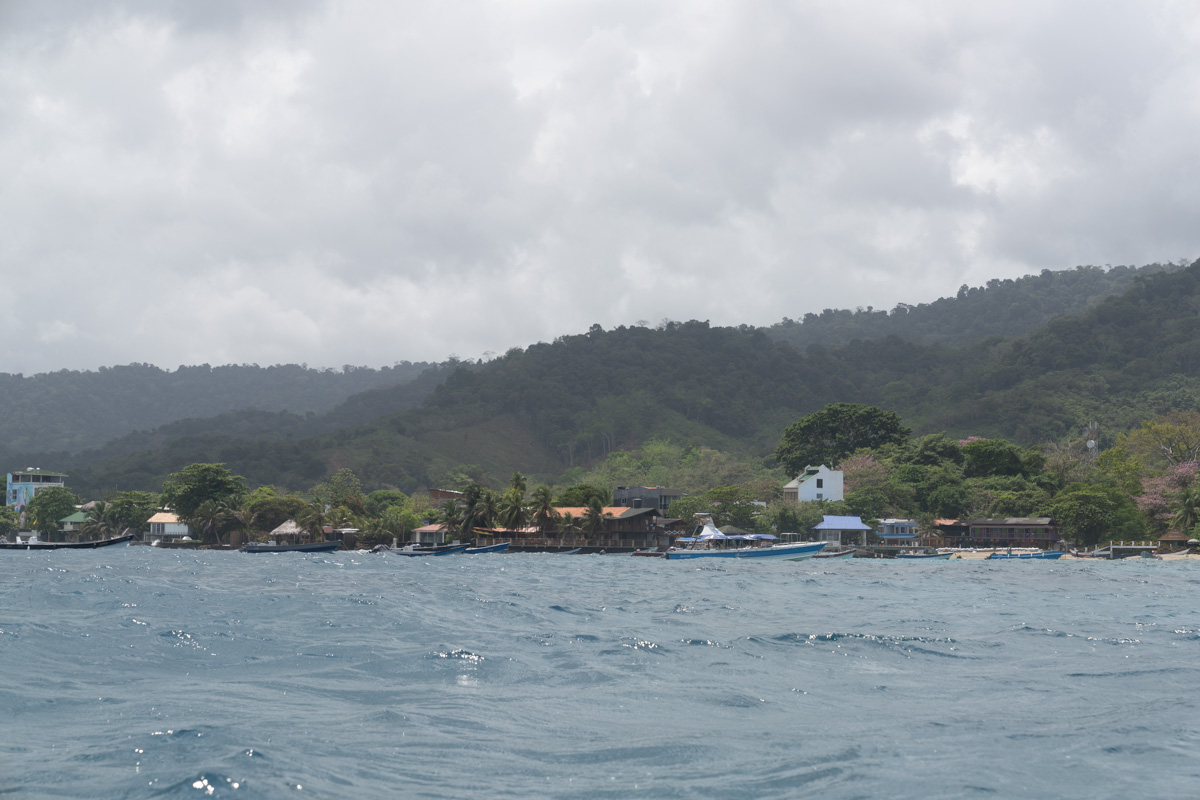
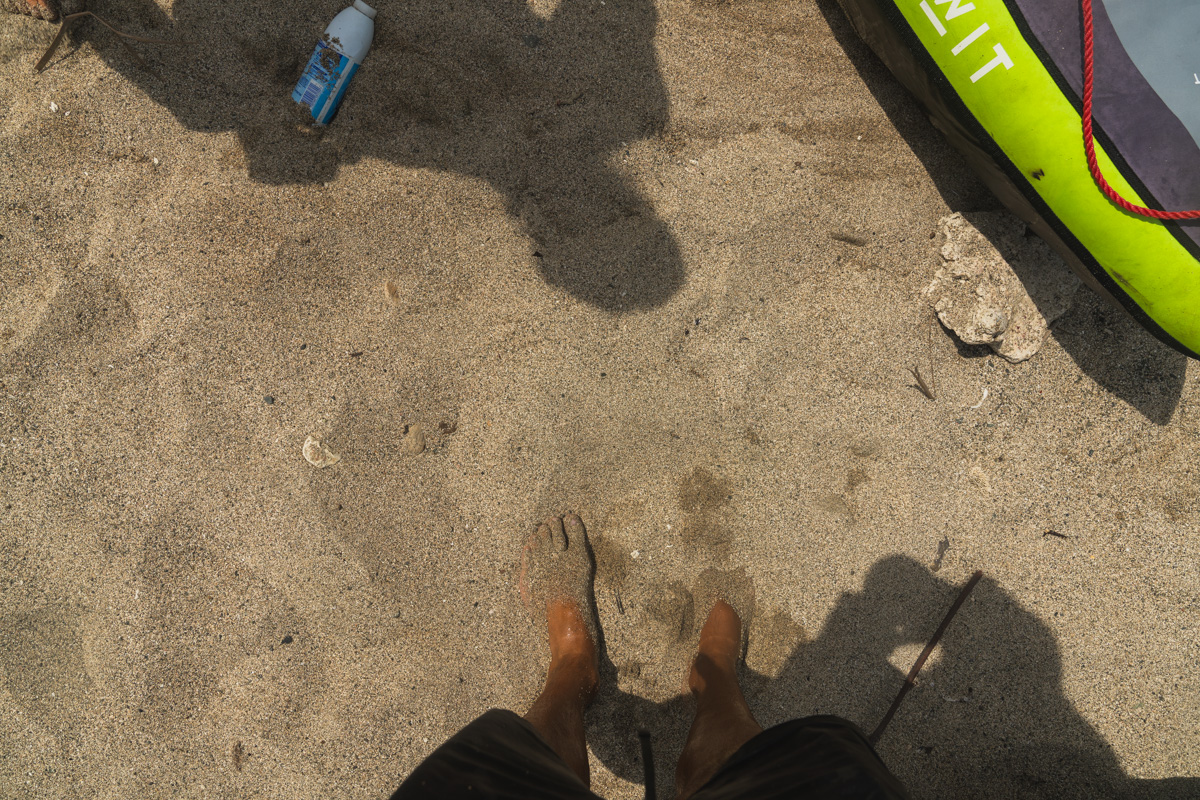
We beached our kayaks in Capargana, high-fiving and hollering with joy. It had been an incredible journey to get here, one of the most challenging things I had ever done. There had been countless moments where I had doubted I would make it her, so I was pretty proud to have finally done it.


We excitedly explored our first Colombia town, it felt like we were in a different world compared to where we had been the last month. Even the tiendas amazed us with the amount of food and drinks they carried. We were used to the bare minimum in all of Guna Yala.
This wasn’t the planned end, though. We had still wanted to kayak across the bay, to avoid having to take a boat. Kacper was ready to keep going but I felt different. I felt so accomplished and finished when we arrived in Capurgana. The idea of kayaking for about four more days did not sound appealing to me. I also had a great friend, Mike the sailor, who I sailed with from Baja Mexico to Mazatlan, who was in Cartegena for only another few days who I really wanted to see.
It was a tough decision, as I also felt like I was abandoning Kacper, but I decided to stop my journey here. It was what was best for me and it made no sense to me to force myself to do it. Kacper was a bit sad, but understanding.
DAY 37
I helped Kacper load up his kayak and watched him paddle away. By now, I was extremely happy with my decision to stop. I would see Kacper again in a few days when he arrived in Cartegena. I took one extra day off here, before starting my journey to Cartegena.
Final Remarks
This truly was a journey of a lifetime for me. It will be a long long time till I do something I think is more challenging and more rewarding than this. I hope I was able to share the amazing beauty of this region and its people with you all. Thank you all for reading my stories and following along.
Right now, I’m writing this from Peru where I am about to begin cycling through the country I have dreamed of for years. I have two more blog posts (Colombia and Ecuador) to finish to finally catch back up to where I am now, so stay tuned for those and don’t forget to subscribe to my email notifications :). Also don’t be scared to leave a comment, I love to read them.